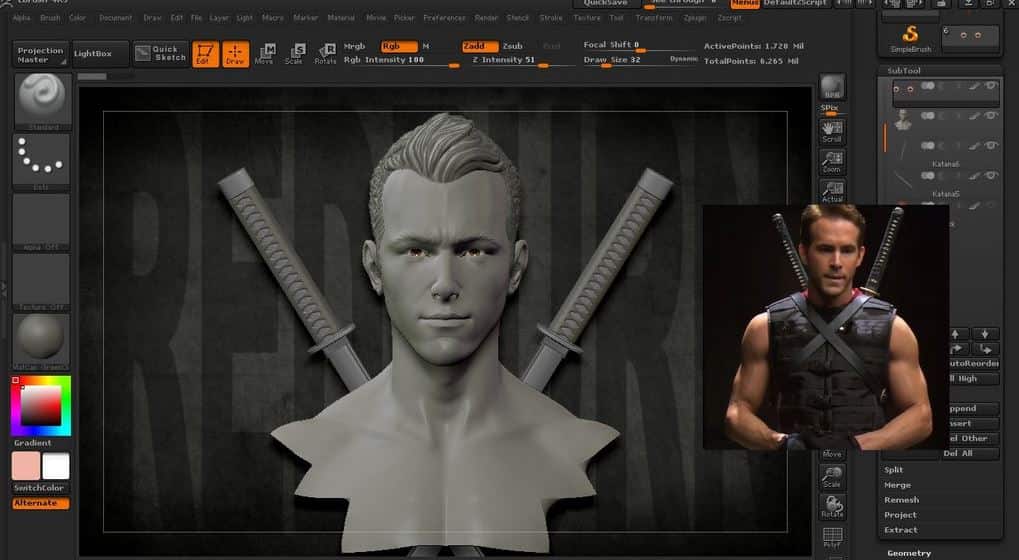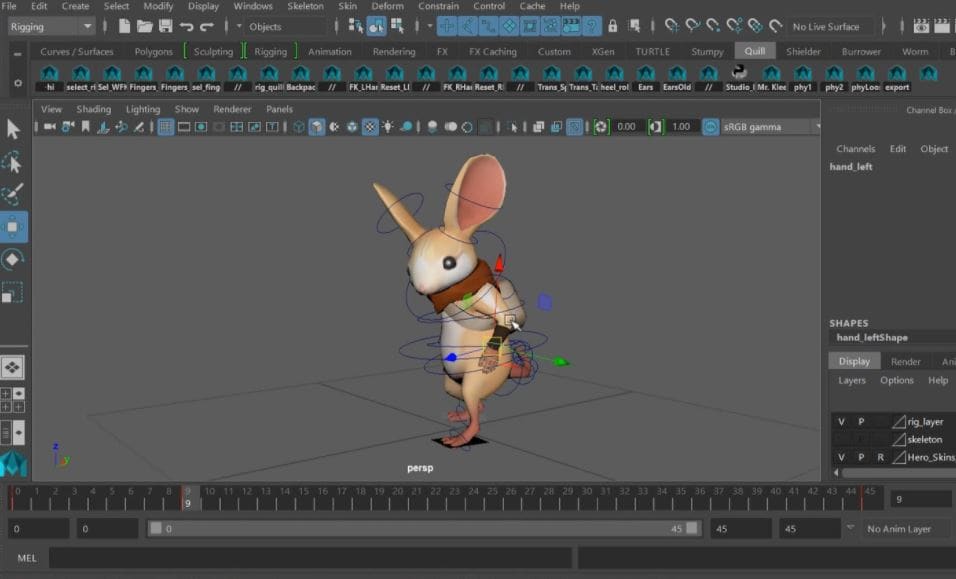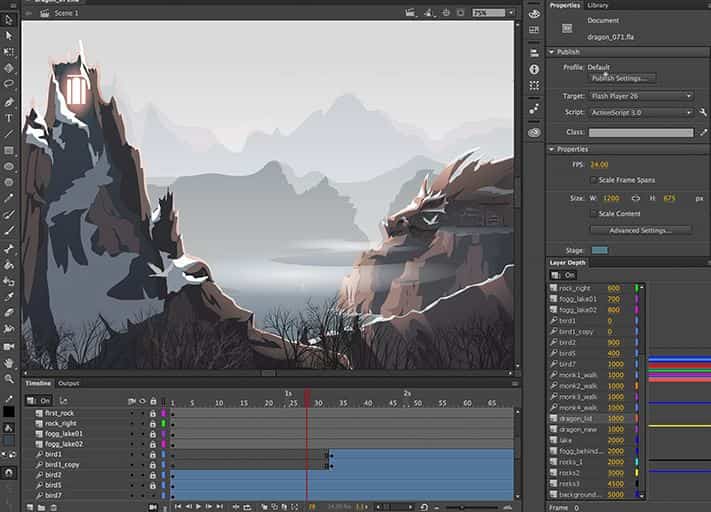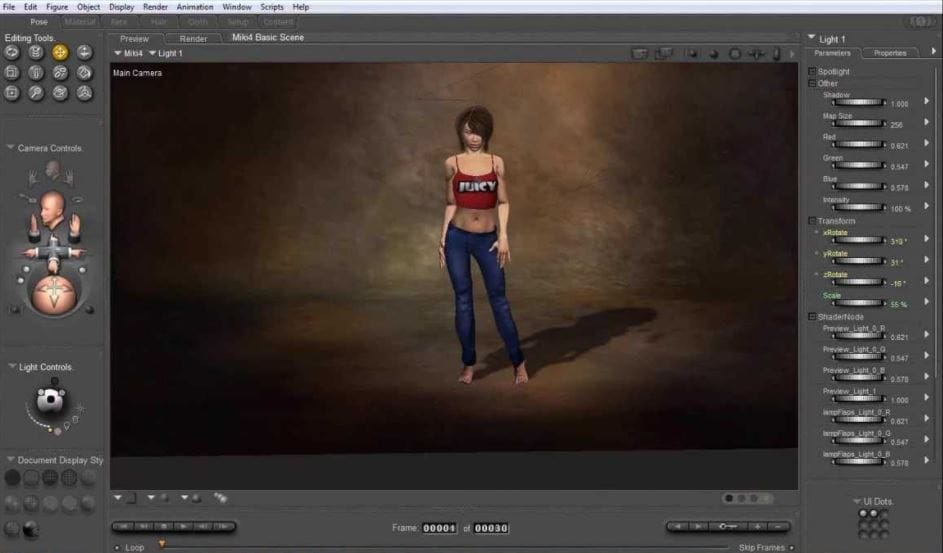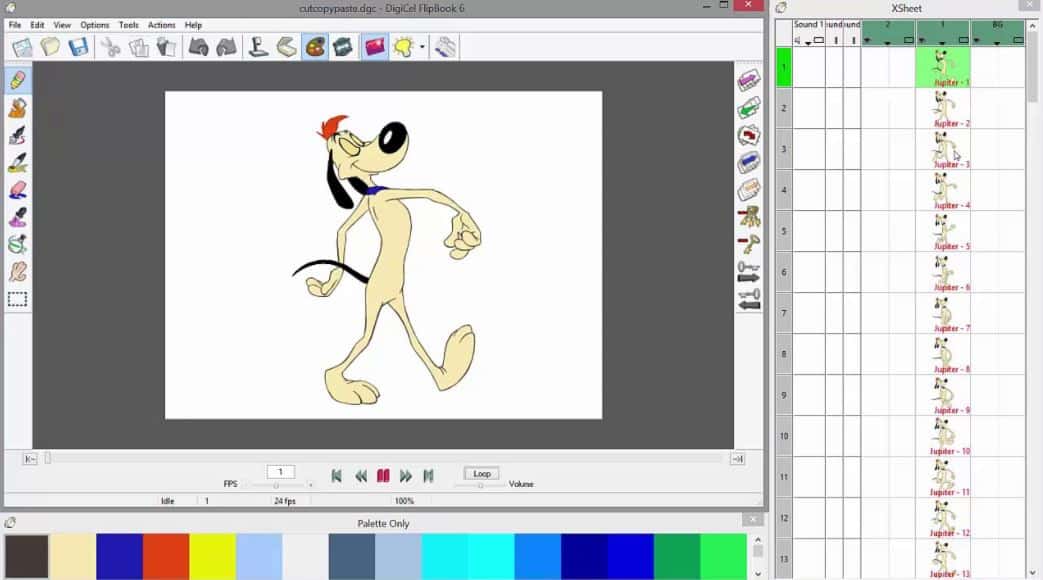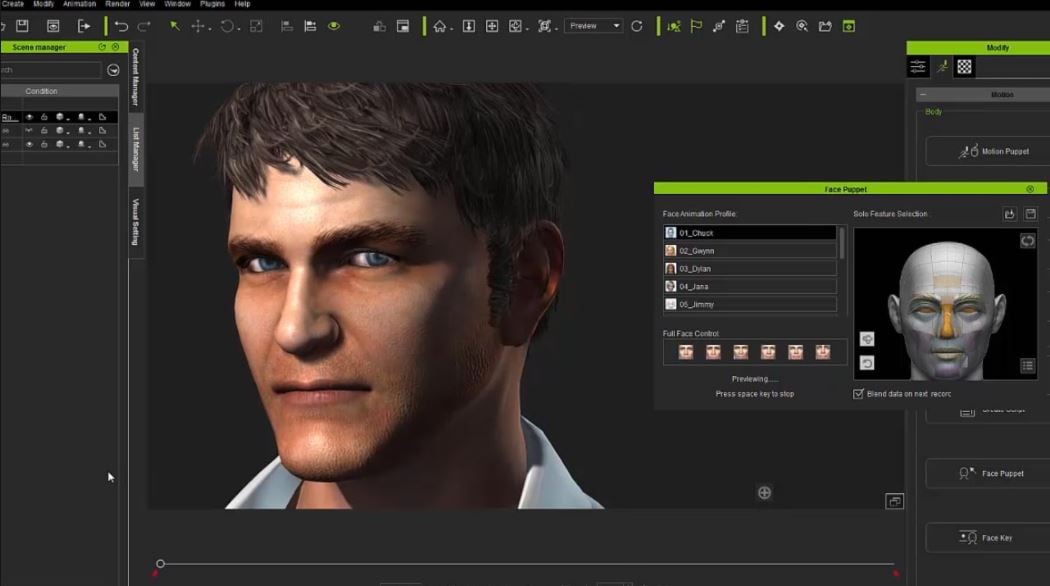:max_bytes(150000):strip_icc():format(webp)/Robothandholdinganapple-fbe6ff482ed641e188dd6650b9ac132e.jpg)
2024 Approved Watermark-Free Video Editing The Top 7 Merging Solutions

Watermark-Free Video Editing: The Top 7 Merging Solutions
Sometimes, when delving into the vast space of internet and trying to find the perfect online platforms or software in order to edit some videos, it might get frustrating to find only the ones with watermark. But of course, the resources are endless and in case we have some information, we can easily access the free video editing platforms which give us the opportunity to edit our videos without undesired logos on them. In this case, we will be discussing 6 video mergers without watermark, and the way we can use them – the tools and features they offer, and how we can get the best out of them.
- Photos by Microsoft
If you are too lazy to get high-quality results using popular video editors, like Filmora, try Photos App. It is a built-in program that usually opens your images on Windows 10, but you can also use it for merging your videos. And guess what? Since it comes within the system, all the features, although limited, are absolutely free.
How to Merge Videos on Windows using Photos App?
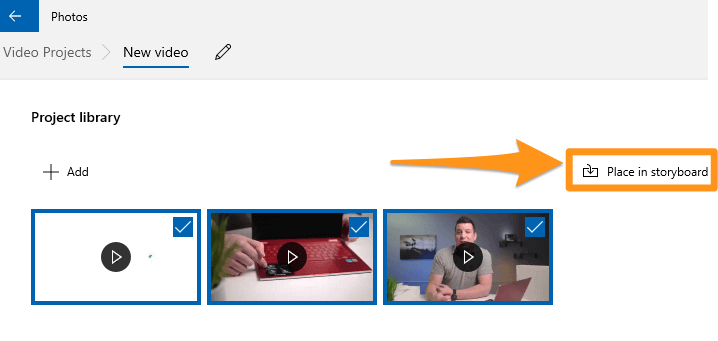
These are the steps to combine multiple clips in Windows 10 with Photos App.
Step 1: Open Photos App
Go to the ‘Start’ menu, find Photos App, and click to open it.
Step 2: Make a New Project
Click the ‘New video project’ (big blue box) under the ‘Video Projects’ tab. Alternatively, you can click the ‘New video’ button and select the ‘New video project’ option from the dropdown menu.
Step 3: Add Clips
Look for the text ‘Project library.’ Then click the ‘+ Add’ button. This will open a new window so you can select the clips you want to combine. Also, import videos one by one in a proper sequence because you cannot arrange them later.
Step 4: Make a Storyboard
After importing all the shots, you want to merge, click the ‘Place in storyboard’ button. This option will add all the chosen clips to your project’s storyboard.
- Fastreel by Movavi
Fastreel is a free online video editor. It is extremely easy to use right away, without installing anything. So, on Fastreel, one can edit videos or use online templates in the browser itself. Actually, the first tool we see in the list of Fastreel tools is to merge a video; then, it can be used in order to compress, make, cut, and create a video. On fastreel, you can add a watermark to a video, if wanted - so, it is very voluntary. As for the merging of a video, when this tool is chosen, it’s pretty simple to understand the steps – you can just drop/add multiple files right away.

The format must be either of the listed: MP4, MOV, MKV, AVI, and WMV, and the total size mustn’t exceed 500 MB. Then, in order to add some transitions, a style can be chosen from the drop-down menu, and after that, you should hit on Continue button to stitch the videos together. For the last step, you can export the result by selecting Download option.
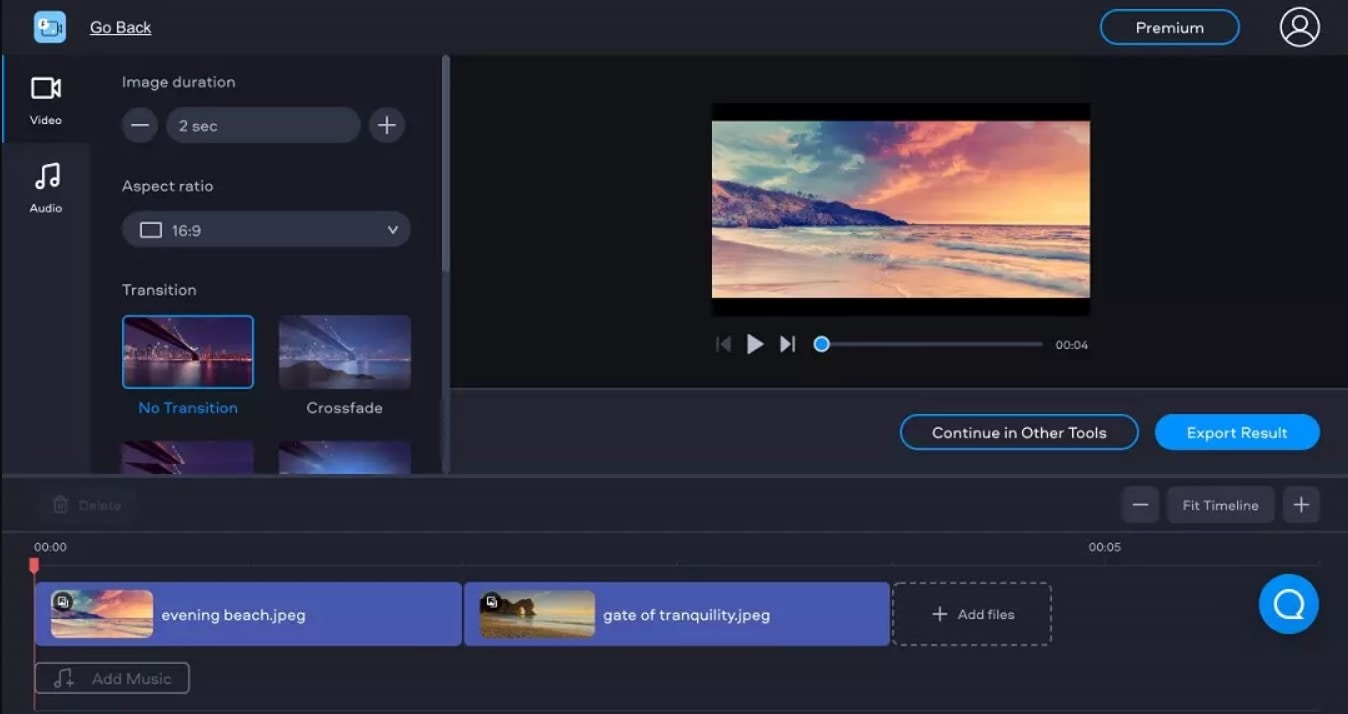
- Free Video Cutter Joiner
Free Video Cutter Joiner – the name already explains it all by itself! This is a free video merger which will not add watermark on your video. The software needs to be downloaded, and contributes to quickly cutting and joining videos. Free Video Cutter Joiner has no size limits – it can cut and merge videos with large file sizes without any trouble, and speed of it to do so is quite fast. It supports several file formats, such as AVI, MPEG, WMV, 3GP FLV, MP4, WMV, MOV, VOB, etc.
So, once downloaded, you will see how user-friendly and straightforward the software is: it shows two of its features right away – video cutter and video joiner. You choose which one you are about to use – so, in our case, video joiner.
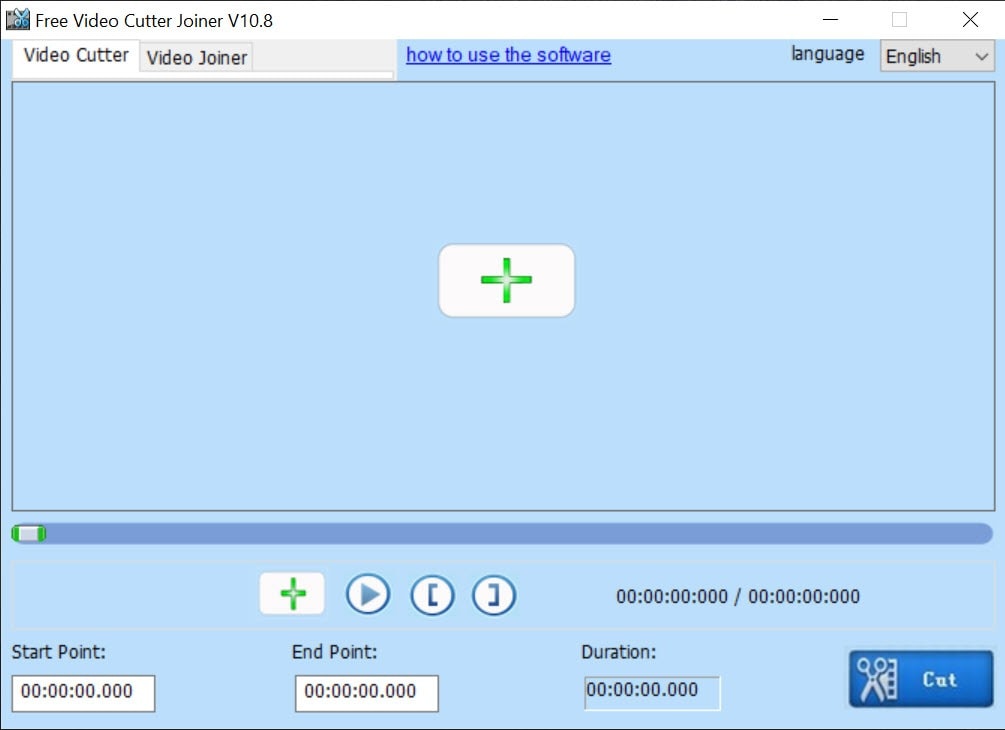
Then, you should click the the “+” icon, which lets you add files from your PC.

Then, hit on the Join button, and choose Indirect Join. Hitting on Start Join will start merging all the uploaded videos, and, wait a little until the process has been completed.
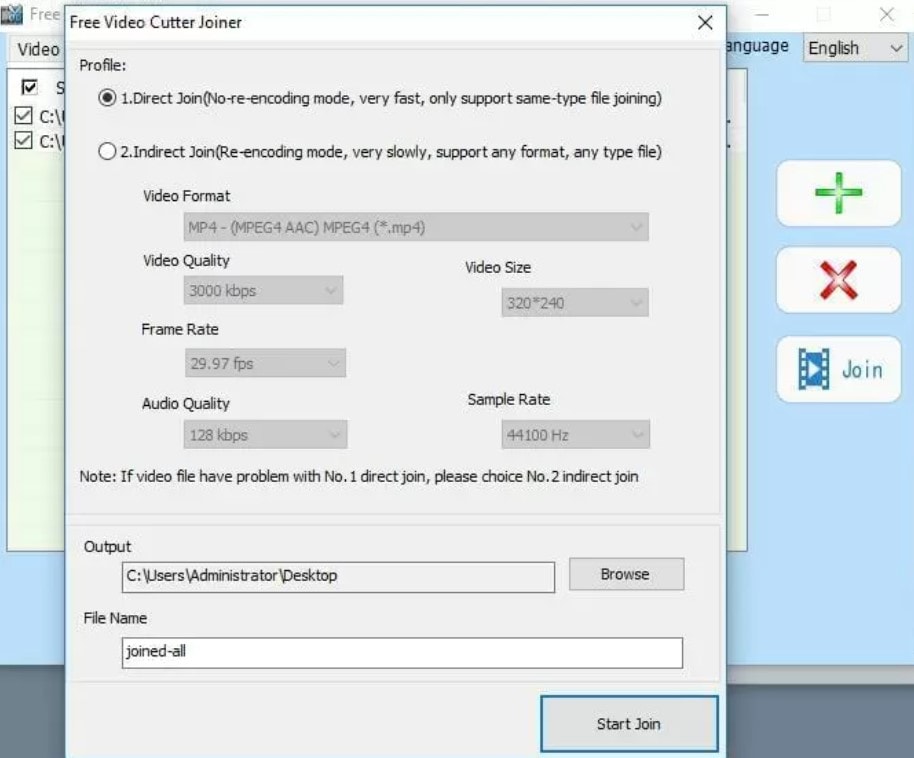
- Clideo
Clideo is the online platform that declares that it makes it super easy to edit all your video files, images and GIFs, and is totally free. It gives us the opportunities to: merge, compress, resize, cut, make, crop, speed, rotate, add music to, loop, flip, reverse, mute, filter, and adjust the videos. Add subtitles, make memes, create slideshows, etc. Therefore, it’s pretty rich in its tools and features.
As for merging videos, much like Fastreel, Clideo is pretty straightforward. You just click on the mentioned tool, and then easily choose files you would like to combine – you can merge any amount of video clips there. Several files can be chosen at the same time, or they can be added one by one.
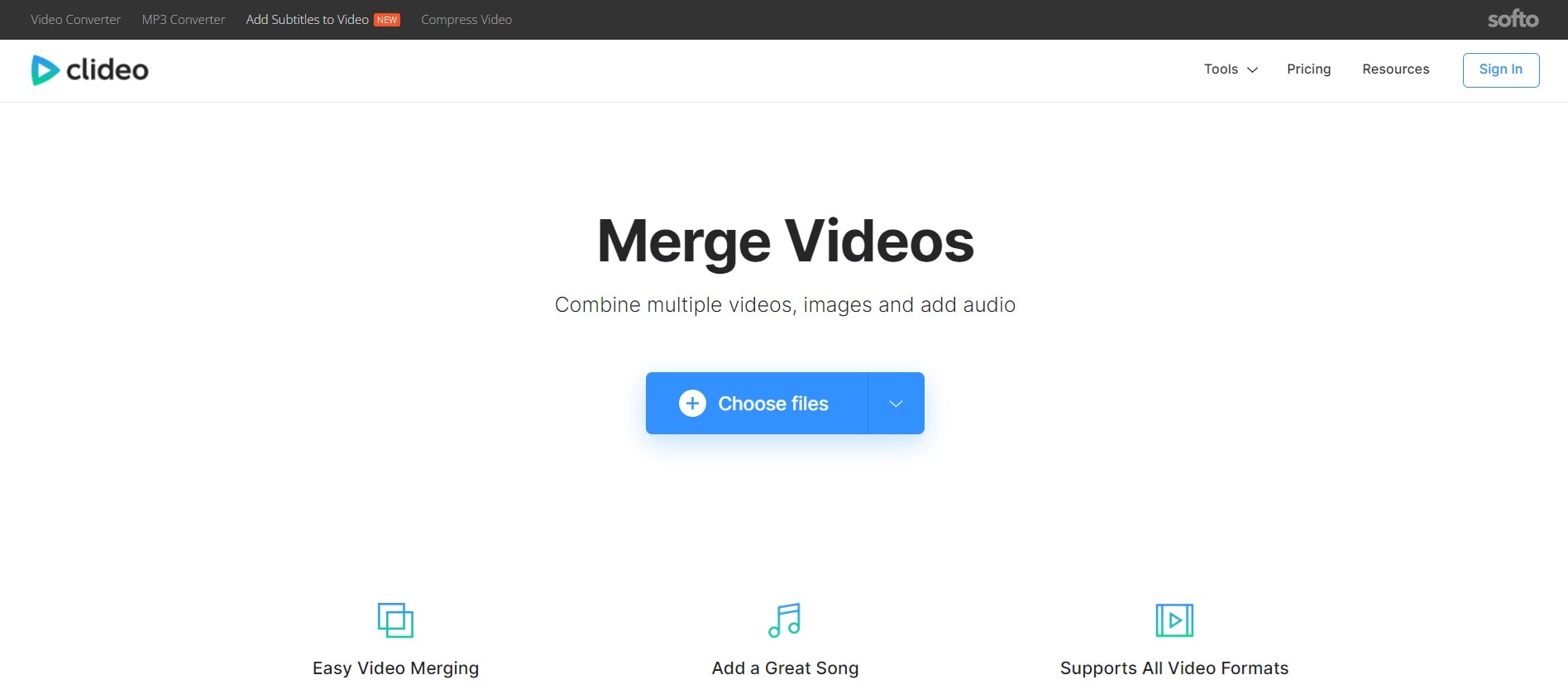
Then it will take you to the editor, where you can join the videos. It’s possible to rearrange the files, by using drag-and-drop until they’re in the desired order. You can also add images and set duration from them, add audio, change its length and volume. The last step is choosing the aspect ratio and clicking the Export button. You can watch the preview of your result and then click on Download if you are satisfied with the merged file.
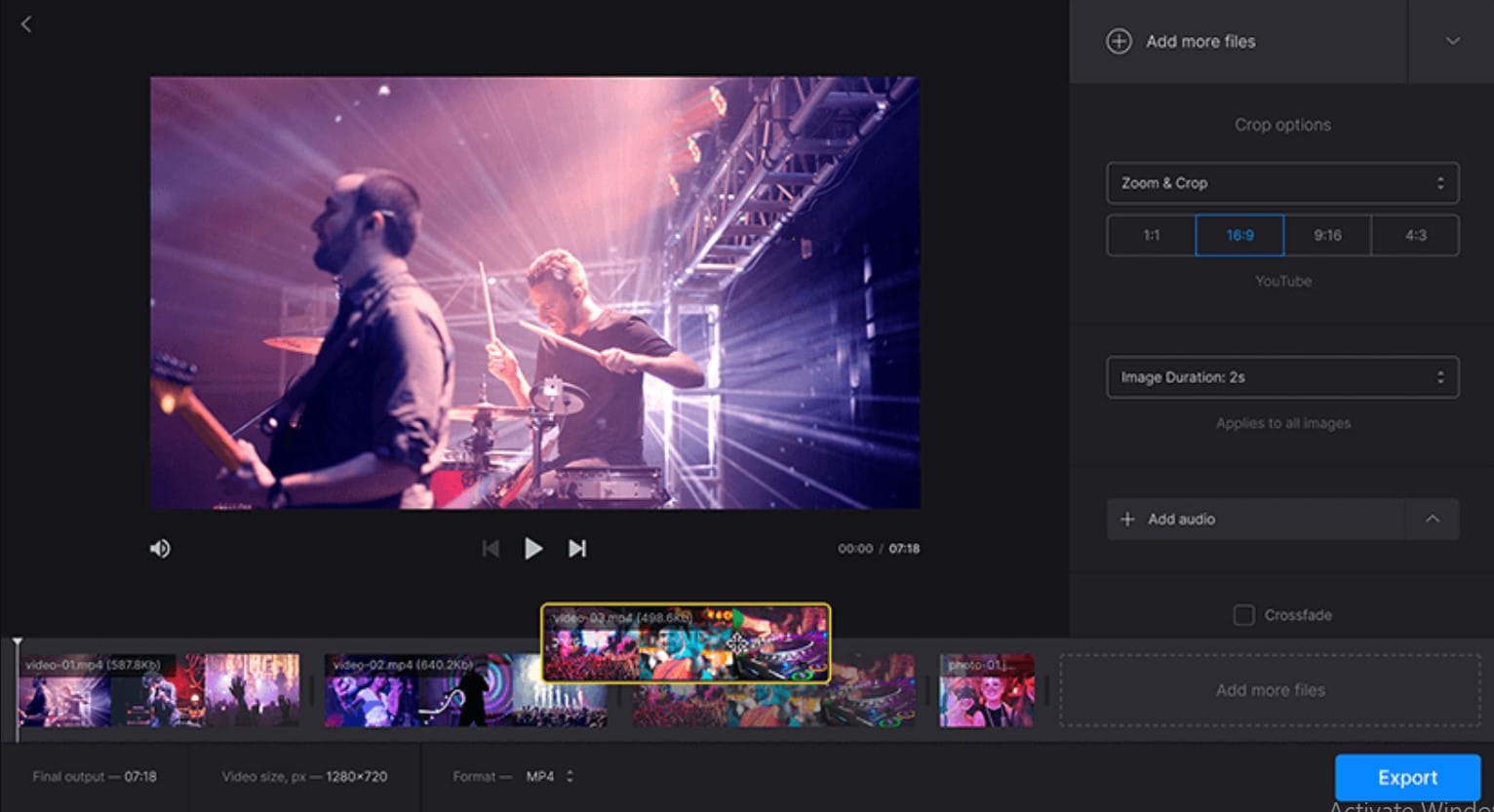
- Typito
Typito is a platform to merge videos online, as well as Fastreel and Clideo. It is free, and mostly aims to create combinations one can use to post on social network such as Instagram, Facebook, and Youtube. Typito supports a great many formats, some of them being MP4, AVI, FLV and WMV. You can edit your videos before merging them by trimming, cropping and resizing, and also add transition effects and music. It quickly combines footage, doesn’t watermark the videos, has brand kit of colors, fonts and style. It can also create collection of images, which is used for making Youtube compilation at most times.
To merge videos, you should choose the tool, then Get Started, and register and sign in first.
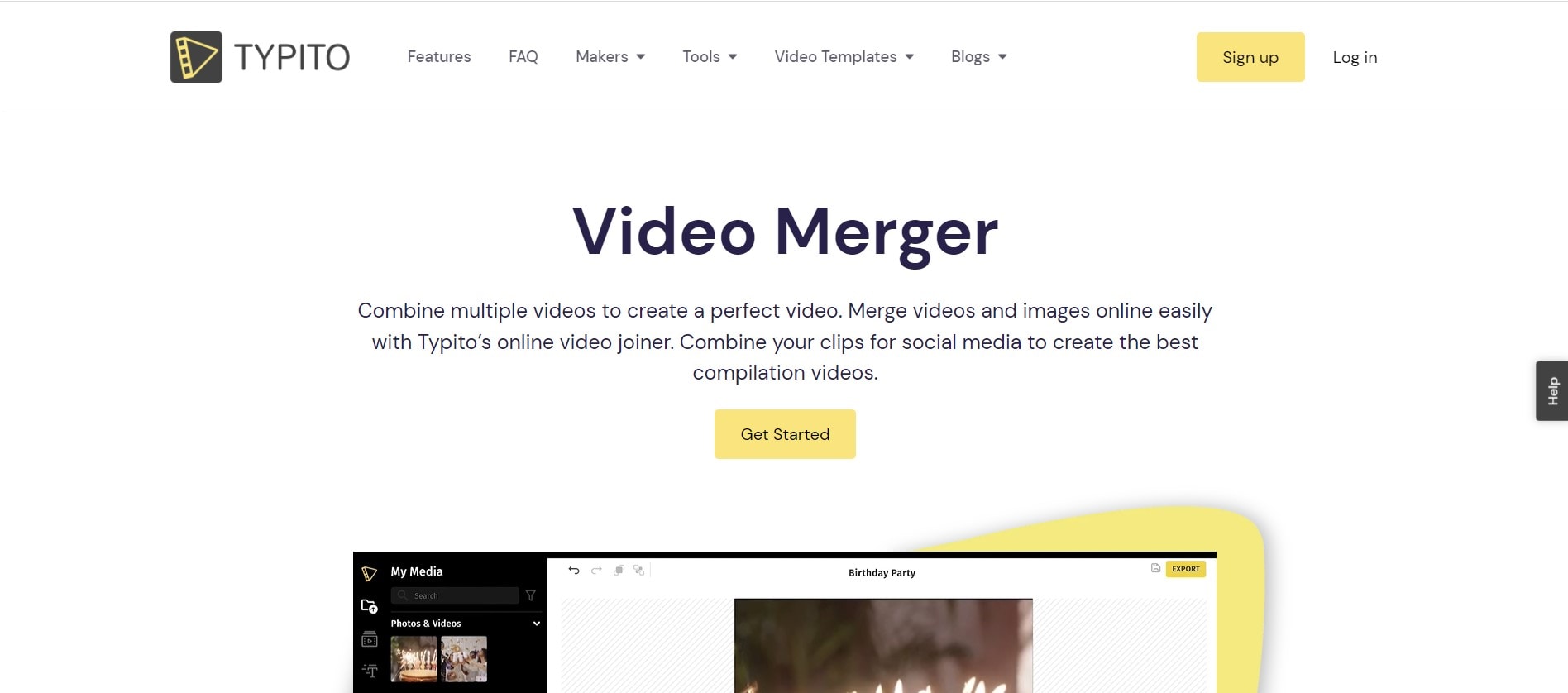
Then click on New Project, choose a video format (the platform offers you the list of the most popular ones), and it will take you to the editor, where you start off by adding media.

Drag and drop images or videos that you want to combine into a single video. You can also click to upload media files from your system or browse our Stock Media library for high-quality stock photos and video. Then, you can put your video clips in order, and work on it, if you want to use different tools, such as: edit, crop, trim, or resize them, as well as add text captions, images, and transitions. After you have previewed your video, you can click on the export button in the top right corner, and then, your merged video will be ready to be shared.
- Online UniConverter
Online UniConverter is the next online platform giving us the chance to merge our videos without watermark. It is an online analogue of Wondershare UniConverter, and is a very powerful platform, where you can trim, split, rotate, adjust, and download videos in HD quality. UniConverter supports numerous video formats, including MP4, AVI, MOV, MP3, WEBM. Online UniConverter offers various transitions and aspect ratios to fit the screen.
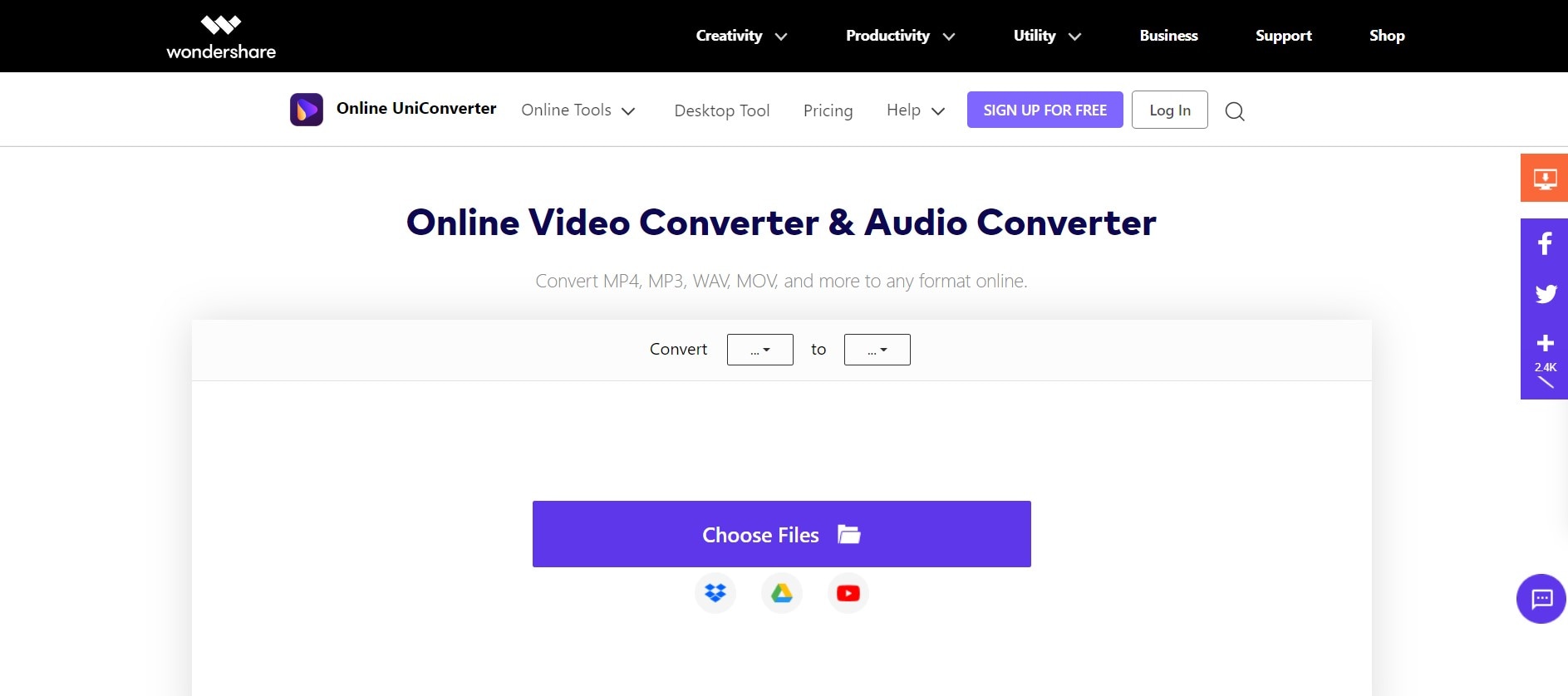
The web-site has lots of tools and features to offer: in the description of it, it reads: video converter, video compressor, video editor, audio converter, audio compressor, audio cutter, GIF maker, YouTube thumbnail, and image resizer. Importing media to the online UniConverter is extremely easy, and combining videos turns out to be a quick process, too.
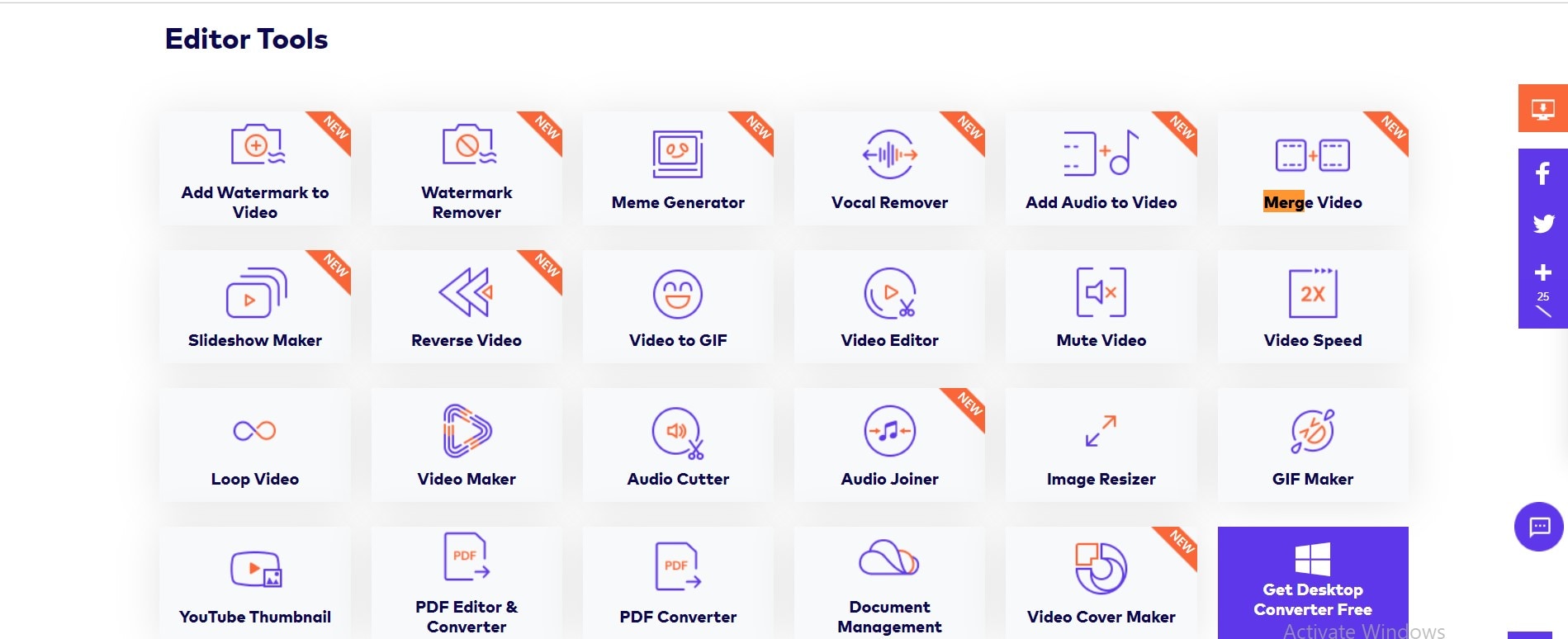
Anyway, if you want to combine a lot of files and the size of them all exceeds 100 MB, you will not be able to use Online Uniconverter for that. It supports the video no more than 100 MB and suggests using Wondershare UniConverter (originally Wondershare Video Converter Ultimate) for Desktop.
- Wondershare Filmora
Last but not least – Filmora Video Editor ! Even it differs from other abovementioned video mergers, as in it is not totally free and adds a Filmora logo on exported project, it’s a great suggestion for people who want to make their videos look great with the help of various tools. When a user is ready to pay, Filmora offers a subscription model, and for a bit more, one can get a permanent license. The software costs $51.99 per year or $79.99 for an outright purchase (prices are regularly discounted).
Wondershare Filmora has a clear and pleasing interface, offers trimming, transitions, overlays, several effects, as well as some more advanced and modern features, such as motion tracking. For this one particular software, we will be offering a step by step guide about how to merge videos there.
For Win 7 or later (64-bit)
For macOS 10.14 or later
- Open the program.
- Choose Import Media Files Here.

- Choose your
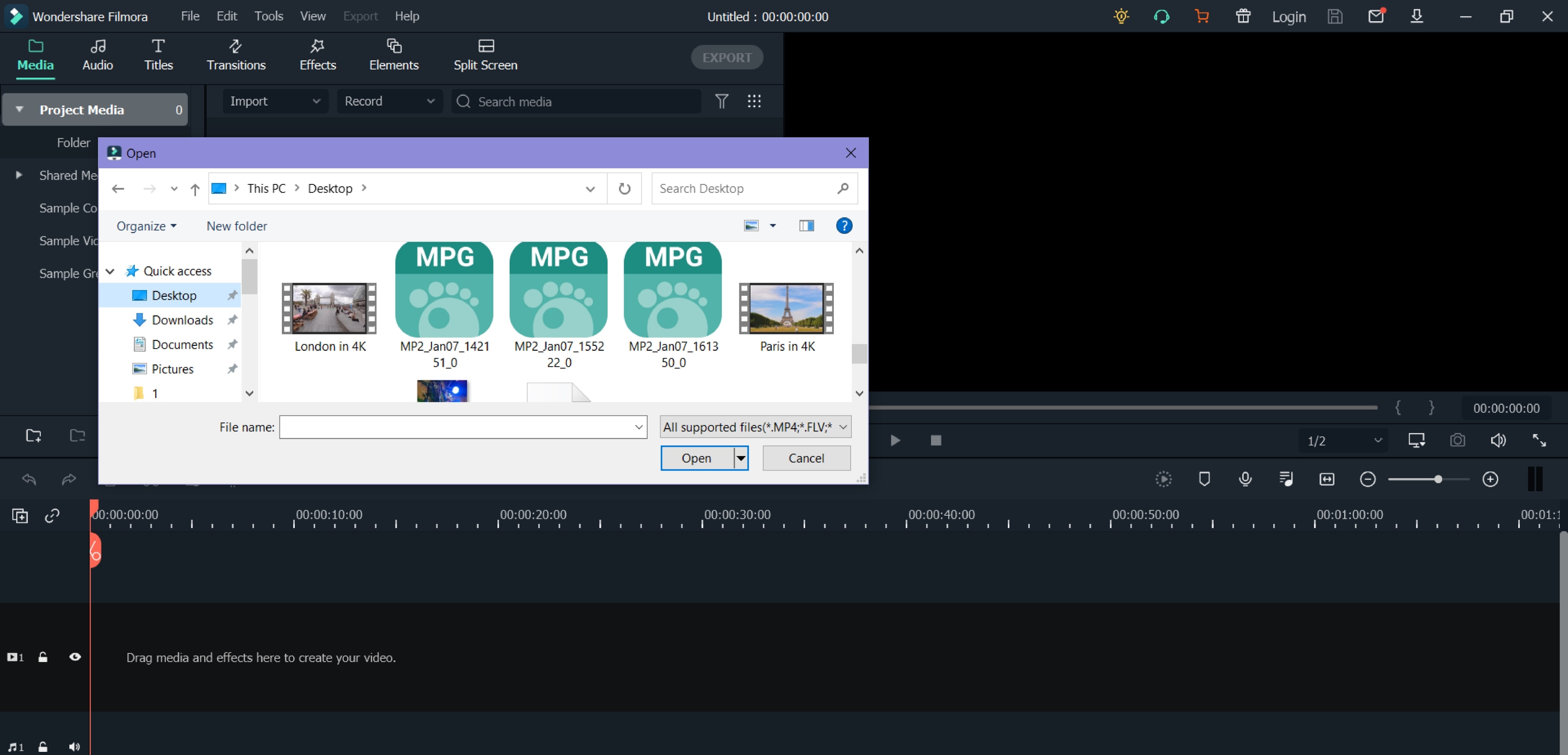
- We can click and drag, essentially, “insert” a video in a sequence below. The Linear Timeline allows us to understand exactly when a video clip ends and when a new one starts.

- Accordingly, we can make one video “sit” next to another. If we want or need it, we will add the third video clip, fourth, and so on.
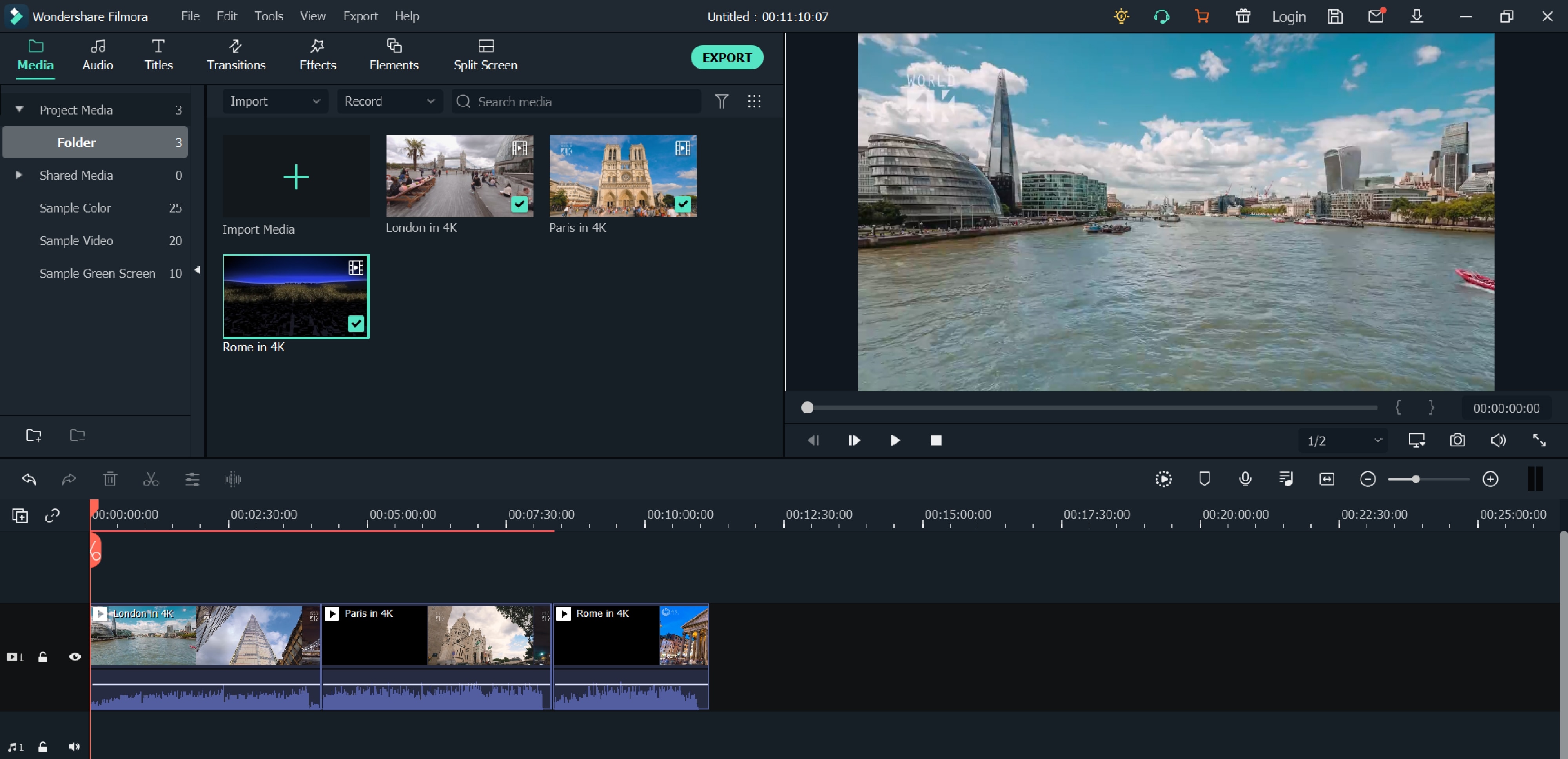
- We can view the entire video and save the video afterwards.
- Start to save video - we make sure the result is exactly what we wanted, find the Export button above the timeline and click on it.
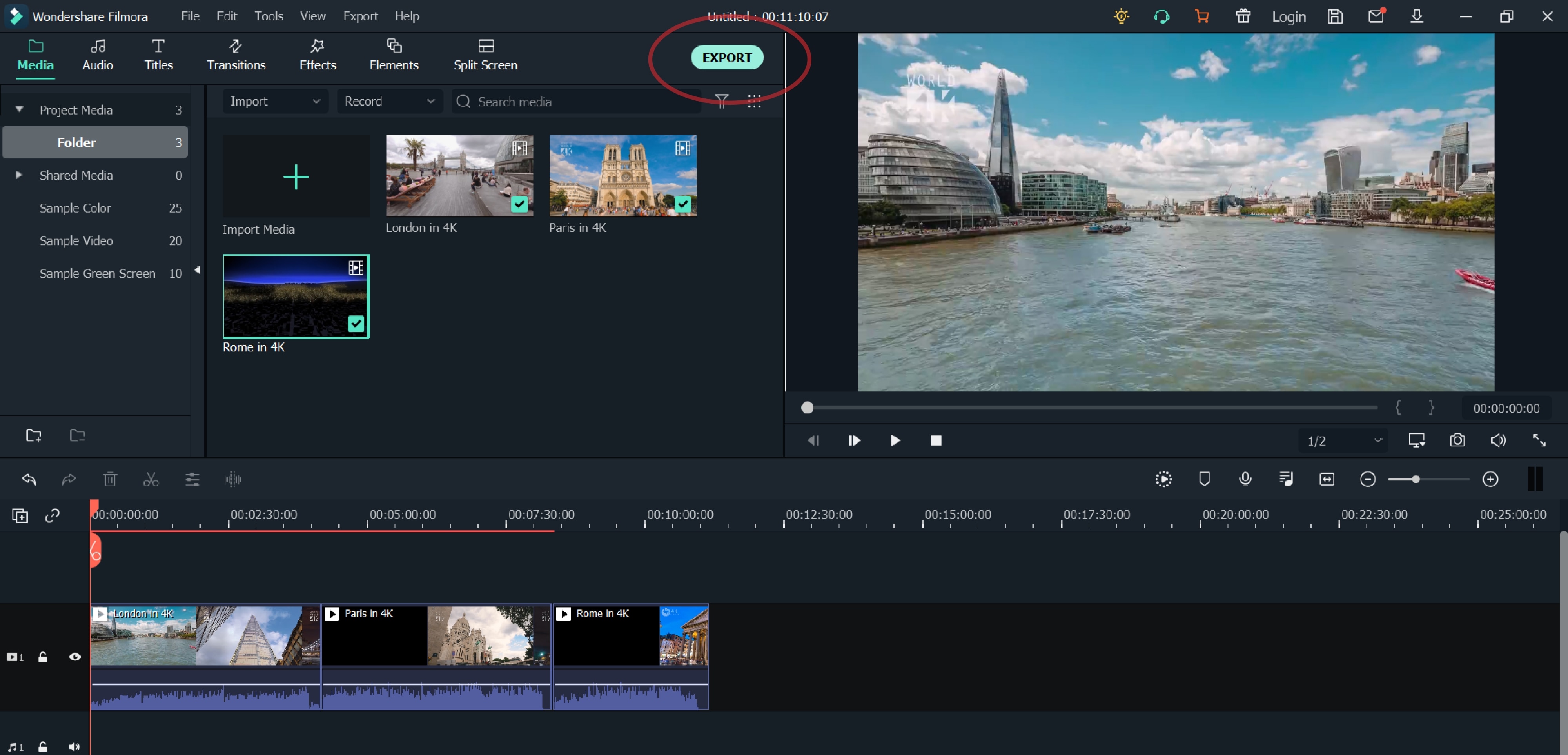
- In the opened window, on the left side, to be precise, if we observe well, we can already choose in which format we want to save our clip. On the right we can indicate what name we want to give to our video; The location where we want to store it; Also, we see the resolution (which we can modify freely after clicking on Settings); Size; Duration.
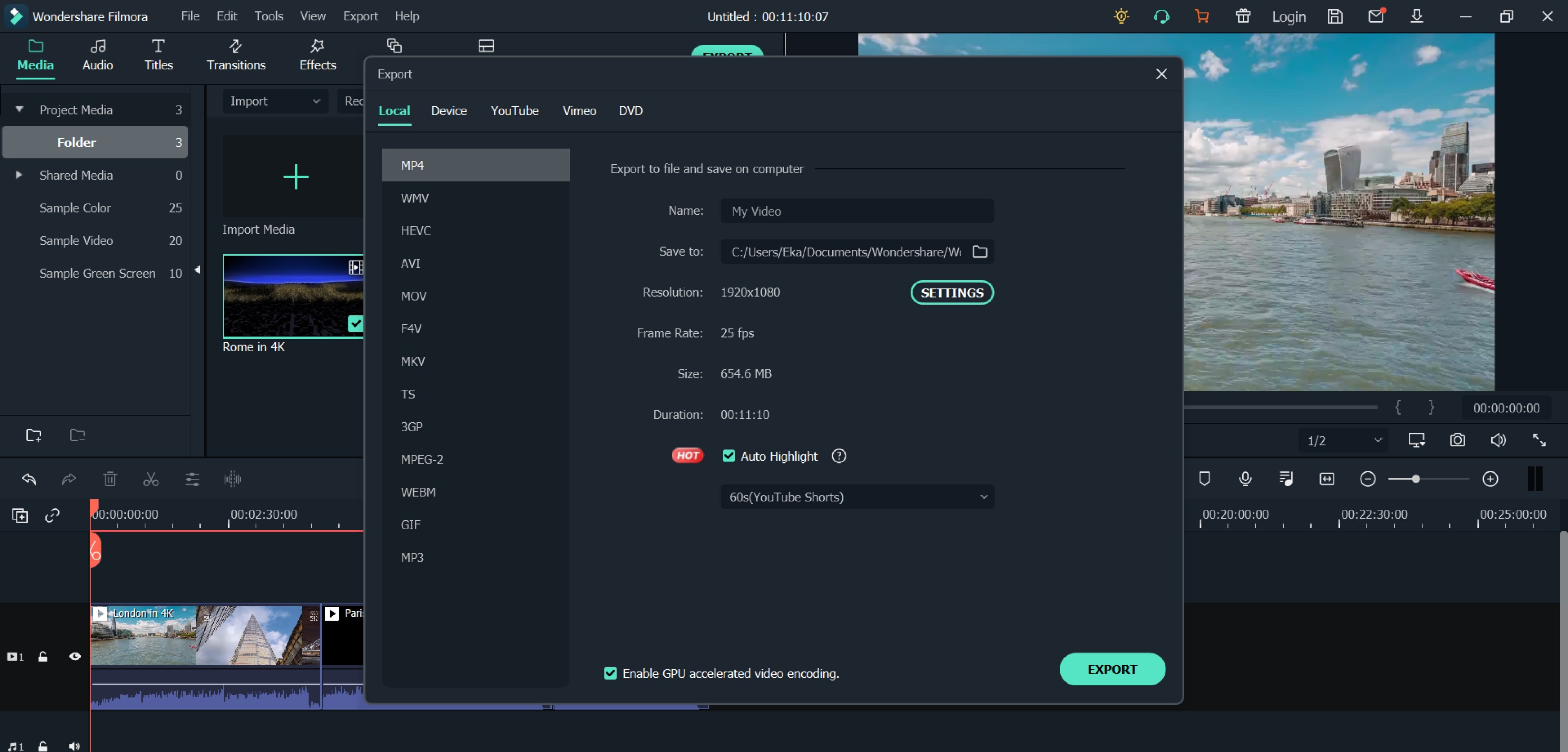
- In Settings, we can decide how much quality the video should have, how many kbps will be the Bit Rate, how many fps the Frame Rate should be, etc., but most likely, beginners will not need to change all this.
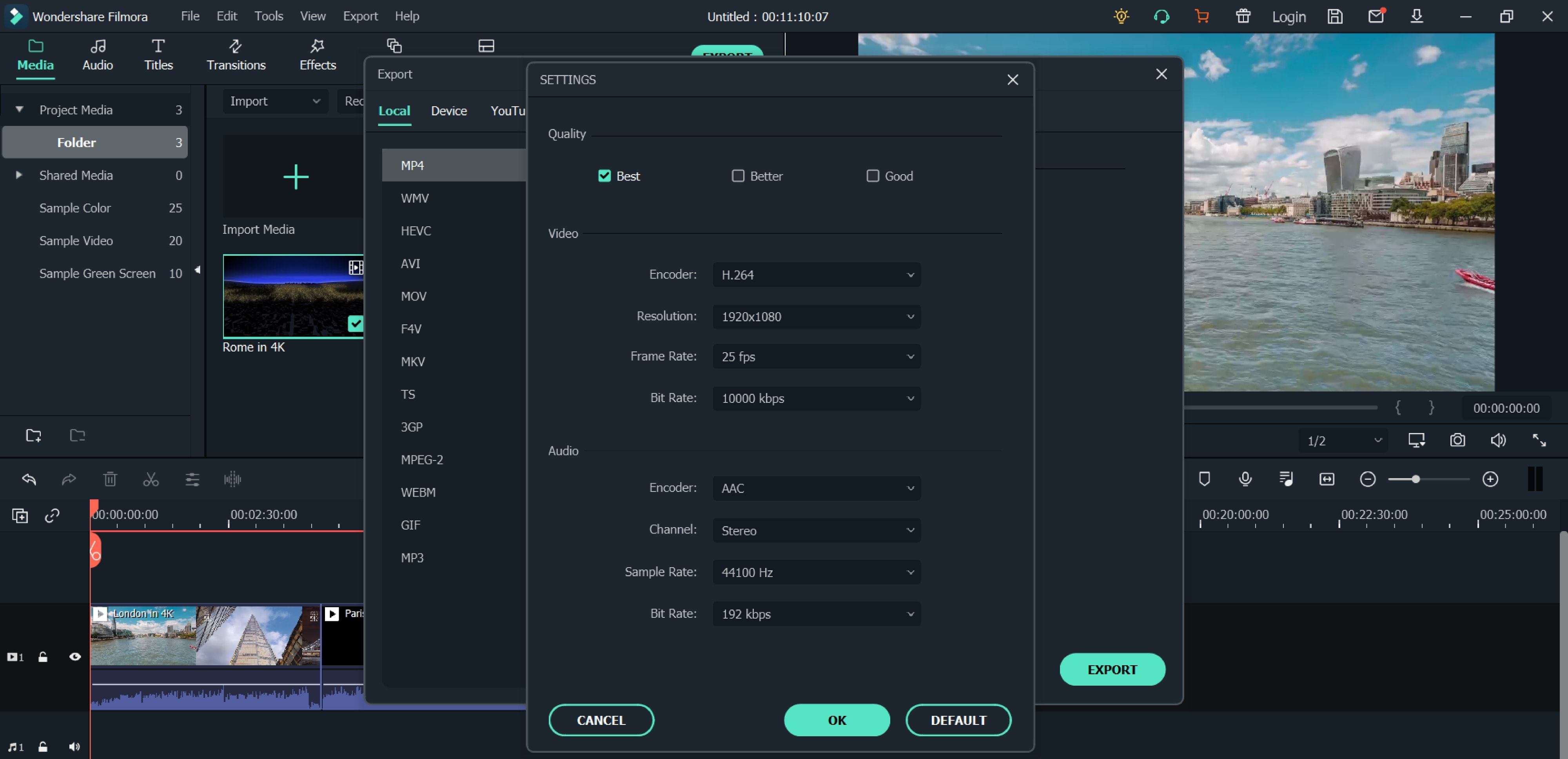
- After selecting everything, right-click on the Export button in the lower right corner of the window and the program will start saving the material.
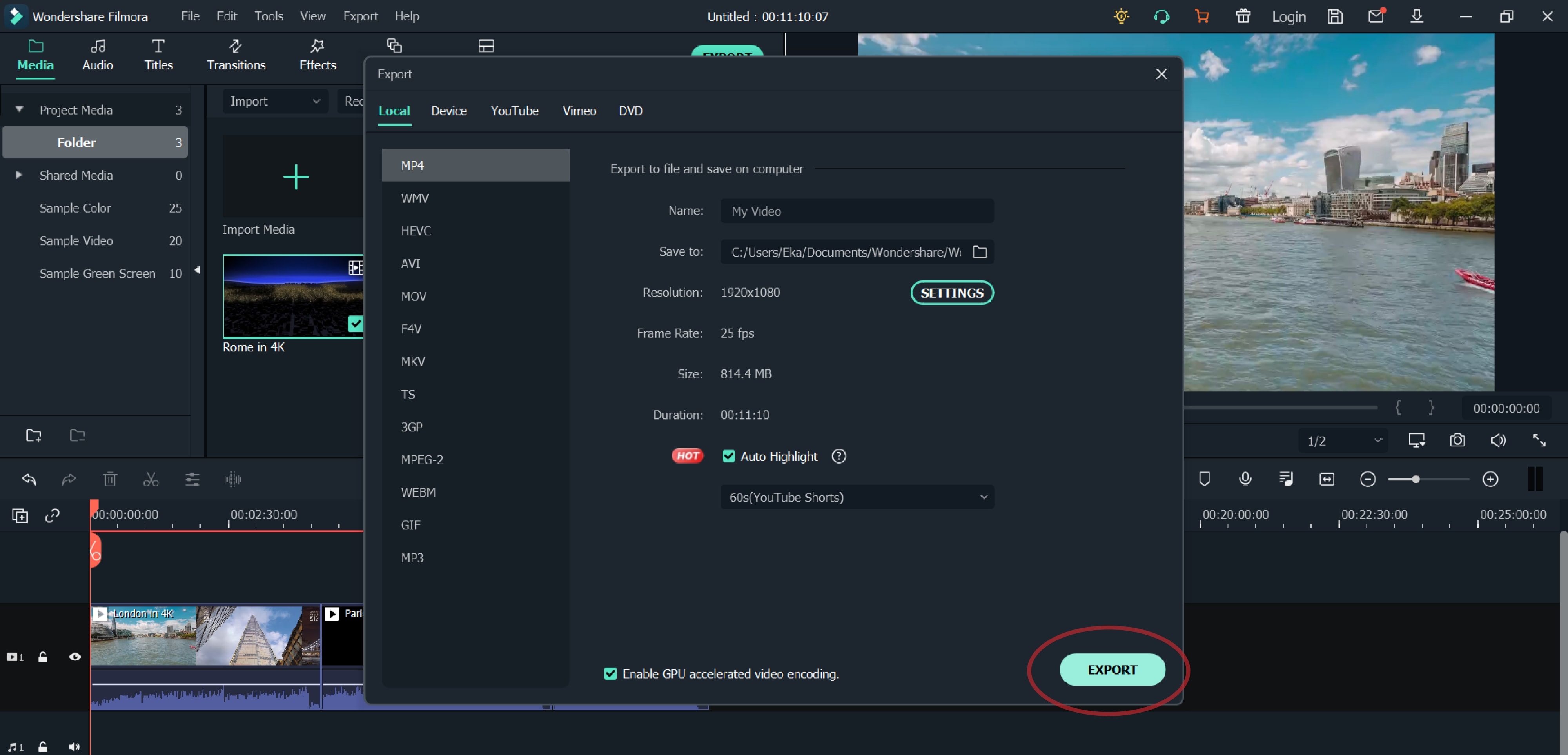

So, in this article, we introduced some online platforms and software for you to use if you would like to merge videos and combine them into one. These are: Fastreel, Free Video Cutter Joiner, Clideo, Typito, Online UniConverter, Wondershare Filmora. It’s up to you which one you would like to choose to merge your videos or edit them in any other way, but you can try either of them and choose to your own liking – even so, of course, there are some other video mergers worth considering, that we might mention in the coming articles. Before then, enjoy with free video editors, without watermark!
If you are too lazy to get high-quality results using popular video editors, like Filmora, try Photos App. It is a built-in program that usually opens your images on Windows 10, but you can also use it for merging your videos. And guess what? Since it comes within the system, all the features, although limited, are absolutely free.
How to Merge Videos on Windows using Photos App?

These are the steps to combine multiple clips in Windows 10 with Photos App.
Step 1: Open Photos App
Go to the ‘Start’ menu, find Photos App, and click to open it.
Step 2: Make a New Project
Click the ‘New video project’ (big blue box) under the ‘Video Projects’ tab. Alternatively, you can click the ‘New video’ button and select the ‘New video project’ option from the dropdown menu.
Step 3: Add Clips
Look for the text ‘Project library.’ Then click the ‘+ Add’ button. This will open a new window so you can select the clips you want to combine. Also, import videos one by one in a proper sequence because you cannot arrange them later.
Step 4: Make a Storyboard
After importing all the shots, you want to merge, click the ‘Place in storyboard’ button. This option will add all the chosen clips to your project’s storyboard.
- Fastreel by Movavi
Fastreel is a free online video editor. It is extremely easy to use right away, without installing anything. So, on Fastreel, one can edit videos or use online templates in the browser itself. Actually, the first tool we see in the list of Fastreel tools is to merge a video; then, it can be used in order to compress, make, cut, and create a video. On fastreel, you can add a watermark to a video, if wanted - so, it is very voluntary. As for the merging of a video, when this tool is chosen, it’s pretty simple to understand the steps – you can just drop/add multiple files right away.

The format must be either of the listed: MP4, MOV, MKV, AVI, and WMV, and the total size mustn’t exceed 500 MB. Then, in order to add some transitions, a style can be chosen from the drop-down menu, and after that, you should hit on Continue button to stitch the videos together. For the last step, you can export the result by selecting Download option.

- Free Video Cutter Joiner
Free Video Cutter Joiner – the name already explains it all by itself! This is a free video merger which will not add watermark on your video. The software needs to be downloaded, and contributes to quickly cutting and joining videos. Free Video Cutter Joiner has no size limits – it can cut and merge videos with large file sizes without any trouble, and speed of it to do so is quite fast. It supports several file formats, such as AVI, MPEG, WMV, 3GP FLV, MP4, WMV, MOV, VOB, etc.
So, once downloaded, you will see how user-friendly and straightforward the software is: it shows two of its features right away – video cutter and video joiner. You choose which one you are about to use – so, in our case, video joiner.

Then, you should click the the “+” icon, which lets you add files from your PC.

Then, hit on the Join button, and choose Indirect Join. Hitting on Start Join will start merging all the uploaded videos, and, wait a little until the process has been completed.

- Clideo
Clideo is the online platform that declares that it makes it super easy to edit all your video files, images and GIFs, and is totally free. It gives us the opportunities to: merge, compress, resize, cut, make, crop, speed, rotate, add music to, loop, flip, reverse, mute, filter, and adjust the videos. Add subtitles, make memes, create slideshows, etc. Therefore, it’s pretty rich in its tools and features.
As for merging videos, much like Fastreel, Clideo is pretty straightforward. You just click on the mentioned tool, and then easily choose files you would like to combine – you can merge any amount of video clips there. Several files can be chosen at the same time, or they can be added one by one.

Then it will take you to the editor, where you can join the videos. It’s possible to rearrange the files, by using drag-and-drop until they’re in the desired order. You can also add images and set duration from them, add audio, change its length and volume. The last step is choosing the aspect ratio and clicking the Export button. You can watch the preview of your result and then click on Download if you are satisfied with the merged file.

- Typito
Typito is a platform to merge videos online, as well as Fastreel and Clideo. It is free, and mostly aims to create combinations one can use to post on social network such as Instagram, Facebook, and Youtube. Typito supports a great many formats, some of them being MP4, AVI, FLV and WMV. You can edit your videos before merging them by trimming, cropping and resizing, and also add transition effects and music. It quickly combines footage, doesn’t watermark the videos, has brand kit of colors, fonts and style. It can also create collection of images, which is used for making Youtube compilation at most times.
To merge videos, you should choose the tool, then Get Started, and register and sign in first.

Then click on New Project, choose a video format (the platform offers you the list of the most popular ones), and it will take you to the editor, where you start off by adding media.

Drag and drop images or videos that you want to combine into a single video. You can also click to upload media files from your system or browse our Stock Media library for high-quality stock photos and video. Then, you can put your video clips in order, and work on it, if you want to use different tools, such as: edit, crop, trim, or resize them, as well as add text captions, images, and transitions. After you have previewed your video, you can click on the export button in the top right corner, and then, your merged video will be ready to be shared.
- Online UniConverter
Online UniConverter is the next online platform giving us the chance to merge our videos without watermark. It is an online analogue of Wondershare UniConverter, and is a very powerful platform, where you can trim, split, rotate, adjust, and download videos in HD quality. UniConverter supports numerous video formats, including MP4, AVI, MOV, MP3, WEBM. Online UniConverter offers various transitions and aspect ratios to fit the screen.

The web-site has lots of tools and features to offer: in the description of it, it reads: video converter, video compressor, video editor, audio converter, audio compressor, audio cutter, GIF maker, YouTube thumbnail, and image resizer. Importing media to the online UniConverter is extremely easy, and combining videos turns out to be a quick process, too.

Anyway, if you want to combine a lot of files and the size of them all exceeds 100 MB, you will not be able to use Online Uniconverter for that. It supports the video no more than 100 MB and suggests using Wondershare UniConverter (originally Wondershare Video Converter Ultimate) for Desktop.
- Wondershare Filmora
Last but not least – Filmora Video Editor ! Even it differs from other abovementioned video mergers, as in it is not totally free and adds a Filmora logo on exported project, it’s a great suggestion for people who want to make their videos look great with the help of various tools. When a user is ready to pay, Filmora offers a subscription model, and for a bit more, one can get a permanent license. The software costs $51.99 per year or $79.99 for an outright purchase (prices are regularly discounted).
Wondershare Filmora has a clear and pleasing interface, offers trimming, transitions, overlays, several effects, as well as some more advanced and modern features, such as motion tracking. For this one particular software, we will be offering a step by step guide about how to merge videos there.
For Win 7 or later (64-bit)
For macOS 10.14 or later
- Open the program.
- Choose Import Media Files Here.

- Choose your

- We can click and drag, essentially, “insert” a video in a sequence below. The Linear Timeline allows us to understand exactly when a video clip ends and when a new one starts.

- Accordingly, we can make one video “sit” next to another. If we want or need it, we will add the third video clip, fourth, and so on.

- We can view the entire video and save the video afterwards.
- Start to save video - we make sure the result is exactly what we wanted, find the Export button above the timeline and click on it.

- In the opened window, on the left side, to be precise, if we observe well, we can already choose in which format we want to save our clip. On the right we can indicate what name we want to give to our video; The location where we want to store it; Also, we see the resolution (which we can modify freely after clicking on Settings); Size; Duration.

- In Settings, we can decide how much quality the video should have, how many kbps will be the Bit Rate, how many fps the Frame Rate should be, etc., but most likely, beginners will not need to change all this.

- After selecting everything, right-click on the Export button in the lower right corner of the window and the program will start saving the material.


So, in this article, we introduced some online platforms and software for you to use if you would like to merge videos and combine them into one. These are: Fastreel, Free Video Cutter Joiner, Clideo, Typito, Online UniConverter, Wondershare Filmora. It’s up to you which one you would like to choose to merge your videos or edit them in any other way, but you can try either of them and choose to your own liking – even so, of course, there are some other video mergers worth considering, that we might mention in the coming articles. Before then, enjoy with free video editors, without watermark!
If you are too lazy to get high-quality results using popular video editors, like Filmora, try Photos App. It is a built-in program that usually opens your images on Windows 10, but you can also use it for merging your videos. And guess what? Since it comes within the system, all the features, although limited, are absolutely free.
How to Merge Videos on Windows using Photos App?

These are the steps to combine multiple clips in Windows 10 with Photos App.
Step 1: Open Photos App
Go to the ‘Start’ menu, find Photos App, and click to open it.
Step 2: Make a New Project
Click the ‘New video project’ (big blue box) under the ‘Video Projects’ tab. Alternatively, you can click the ‘New video’ button and select the ‘New video project’ option from the dropdown menu.
Step 3: Add Clips
Look for the text ‘Project library.’ Then click the ‘+ Add’ button. This will open a new window so you can select the clips you want to combine. Also, import videos one by one in a proper sequence because you cannot arrange them later.
Step 4: Make a Storyboard
After importing all the shots, you want to merge, click the ‘Place in storyboard’ button. This option will add all the chosen clips to your project’s storyboard.
- Fastreel by Movavi
Fastreel is a free online video editor. It is extremely easy to use right away, without installing anything. So, on Fastreel, one can edit videos or use online templates in the browser itself. Actually, the first tool we see in the list of Fastreel tools is to merge a video; then, it can be used in order to compress, make, cut, and create a video. On fastreel, you can add a watermark to a video, if wanted - so, it is very voluntary. As for the merging of a video, when this tool is chosen, it’s pretty simple to understand the steps – you can just drop/add multiple files right away.

The format must be either of the listed: MP4, MOV, MKV, AVI, and WMV, and the total size mustn’t exceed 500 MB. Then, in order to add some transitions, a style can be chosen from the drop-down menu, and after that, you should hit on Continue button to stitch the videos together. For the last step, you can export the result by selecting Download option.

- Free Video Cutter Joiner
Free Video Cutter Joiner – the name already explains it all by itself! This is a free video merger which will not add watermark on your video. The software needs to be downloaded, and contributes to quickly cutting and joining videos. Free Video Cutter Joiner has no size limits – it can cut and merge videos with large file sizes without any trouble, and speed of it to do so is quite fast. It supports several file formats, such as AVI, MPEG, WMV, 3GP FLV, MP4, WMV, MOV, VOB, etc.
So, once downloaded, you will see how user-friendly and straightforward the software is: it shows two of its features right away – video cutter and video joiner. You choose which one you are about to use – so, in our case, video joiner.

Then, you should click the the “+” icon, which lets you add files from your PC.

Then, hit on the Join button, and choose Indirect Join. Hitting on Start Join will start merging all the uploaded videos, and, wait a little until the process has been completed.

- Clideo
Clideo is the online platform that declares that it makes it super easy to edit all your video files, images and GIFs, and is totally free. It gives us the opportunities to: merge, compress, resize, cut, make, crop, speed, rotate, add music to, loop, flip, reverse, mute, filter, and adjust the videos. Add subtitles, make memes, create slideshows, etc. Therefore, it’s pretty rich in its tools and features.
As for merging videos, much like Fastreel, Clideo is pretty straightforward. You just click on the mentioned tool, and then easily choose files you would like to combine – you can merge any amount of video clips there. Several files can be chosen at the same time, or they can be added one by one.

Then it will take you to the editor, where you can join the videos. It’s possible to rearrange the files, by using drag-and-drop until they’re in the desired order. You can also add images and set duration from them, add audio, change its length and volume. The last step is choosing the aspect ratio and clicking the Export button. You can watch the preview of your result and then click on Download if you are satisfied with the merged file.

- Typito
Typito is a platform to merge videos online, as well as Fastreel and Clideo. It is free, and mostly aims to create combinations one can use to post on social network such as Instagram, Facebook, and Youtube. Typito supports a great many formats, some of them being MP4, AVI, FLV and WMV. You can edit your videos before merging them by trimming, cropping and resizing, and also add transition effects and music. It quickly combines footage, doesn’t watermark the videos, has brand kit of colors, fonts and style. It can also create collection of images, which is used for making Youtube compilation at most times.
To merge videos, you should choose the tool, then Get Started, and register and sign in first.

Then click on New Project, choose a video format (the platform offers you the list of the most popular ones), and it will take you to the editor, where you start off by adding media.

Drag and drop images or videos that you want to combine into a single video. You can also click to upload media files from your system or browse our Stock Media library for high-quality stock photos and video. Then, you can put your video clips in order, and work on it, if you want to use different tools, such as: edit, crop, trim, or resize them, as well as add text captions, images, and transitions. After you have previewed your video, you can click on the export button in the top right corner, and then, your merged video will be ready to be shared.
- Online UniConverter
Online UniConverter is the next online platform giving us the chance to merge our videos without watermark. It is an online analogue of Wondershare UniConverter, and is a very powerful platform, where you can trim, split, rotate, adjust, and download videos in HD quality. UniConverter supports numerous video formats, including MP4, AVI, MOV, MP3, WEBM. Online UniConverter offers various transitions and aspect ratios to fit the screen.

The web-site has lots of tools and features to offer: in the description of it, it reads: video converter, video compressor, video editor, audio converter, audio compressor, audio cutter, GIF maker, YouTube thumbnail, and image resizer. Importing media to the online UniConverter is extremely easy, and combining videos turns out to be a quick process, too.

Anyway, if you want to combine a lot of files and the size of them all exceeds 100 MB, you will not be able to use Online Uniconverter for that. It supports the video no more than 100 MB and suggests using Wondershare UniConverter (originally Wondershare Video Converter Ultimate) for Desktop.
- Wondershare Filmora
Last but not least – Filmora Video Editor ! Even it differs from other abovementioned video mergers, as in it is not totally free and adds a Filmora logo on exported project, it’s a great suggestion for people who want to make their videos look great with the help of various tools. When a user is ready to pay, Filmora offers a subscription model, and for a bit more, one can get a permanent license. The software costs $51.99 per year or $79.99 for an outright purchase (prices are regularly discounted).
Wondershare Filmora has a clear and pleasing interface, offers trimming, transitions, overlays, several effects, as well as some more advanced and modern features, such as motion tracking. For this one particular software, we will be offering a step by step guide about how to merge videos there.
For Win 7 or later (64-bit)
For macOS 10.14 or later
- Open the program.
- Choose Import Media Files Here.

- Choose your

- We can click and drag, essentially, “insert” a video in a sequence below. The Linear Timeline allows us to understand exactly when a video clip ends and when a new one starts.

- Accordingly, we can make one video “sit” next to another. If we want or need it, we will add the third video clip, fourth, and so on.

- We can view the entire video and save the video afterwards.
- Start to save video - we make sure the result is exactly what we wanted, find the Export button above the timeline and click on it.

- In the opened window, on the left side, to be precise, if we observe well, we can already choose in which format we want to save our clip. On the right we can indicate what name we want to give to our video; The location where we want to store it; Also, we see the resolution (which we can modify freely after clicking on Settings); Size; Duration.

- In Settings, we can decide how much quality the video should have, how many kbps will be the Bit Rate, how many fps the Frame Rate should be, etc., but most likely, beginners will not need to change all this.

- After selecting everything, right-click on the Export button in the lower right corner of the window and the program will start saving the material.


So, in this article, we introduced some online platforms and software for you to use if you would like to merge videos and combine them into one. These are: Fastreel, Free Video Cutter Joiner, Clideo, Typito, Online UniConverter, Wondershare Filmora. It’s up to you which one you would like to choose to merge your videos or edit them in any other way, but you can try either of them and choose to your own liking – even so, of course, there are some other video mergers worth considering, that we might mention in the coming articles. Before then, enjoy with free video editors, without watermark!
If you are too lazy to get high-quality results using popular video editors, like Filmora, try Photos App. It is a built-in program that usually opens your images on Windows 10, but you can also use it for merging your videos. And guess what? Since it comes within the system, all the features, although limited, are absolutely free.
How to Merge Videos on Windows using Photos App?

These are the steps to combine multiple clips in Windows 10 with Photos App.
Step 1: Open Photos App
Go to the ‘Start’ menu, find Photos App, and click to open it.
Step 2: Make a New Project
Click the ‘New video project’ (big blue box) under the ‘Video Projects’ tab. Alternatively, you can click the ‘New video’ button and select the ‘New video project’ option from the dropdown menu.
Step 3: Add Clips
Look for the text ‘Project library.’ Then click the ‘+ Add’ button. This will open a new window so you can select the clips you want to combine. Also, import videos one by one in a proper sequence because you cannot arrange them later.
Step 4: Make a Storyboard
After importing all the shots, you want to merge, click the ‘Place in storyboard’ button. This option will add all the chosen clips to your project’s storyboard.
- Fastreel by Movavi
Fastreel is a free online video editor. It is extremely easy to use right away, without installing anything. So, on Fastreel, one can edit videos or use online templates in the browser itself. Actually, the first tool we see in the list of Fastreel tools is to merge a video; then, it can be used in order to compress, make, cut, and create a video. On fastreel, you can add a watermark to a video, if wanted - so, it is very voluntary. As for the merging of a video, when this tool is chosen, it’s pretty simple to understand the steps – you can just drop/add multiple files right away.

The format must be either of the listed: MP4, MOV, MKV, AVI, and WMV, and the total size mustn’t exceed 500 MB. Then, in order to add some transitions, a style can be chosen from the drop-down menu, and after that, you should hit on Continue button to stitch the videos together. For the last step, you can export the result by selecting Download option.

- Free Video Cutter Joiner
Free Video Cutter Joiner – the name already explains it all by itself! This is a free video merger which will not add watermark on your video. The software needs to be downloaded, and contributes to quickly cutting and joining videos. Free Video Cutter Joiner has no size limits – it can cut and merge videos with large file sizes without any trouble, and speed of it to do so is quite fast. It supports several file formats, such as AVI, MPEG, WMV, 3GP FLV, MP4, WMV, MOV, VOB, etc.
So, once downloaded, you will see how user-friendly and straightforward the software is: it shows two of its features right away – video cutter and video joiner. You choose which one you are about to use – so, in our case, video joiner.

Then, you should click the the “+” icon, which lets you add files from your PC.

Then, hit on the Join button, and choose Indirect Join. Hitting on Start Join will start merging all the uploaded videos, and, wait a little until the process has been completed.

- Clideo
Clideo is the online platform that declares that it makes it super easy to edit all your video files, images and GIFs, and is totally free. It gives us the opportunities to: merge, compress, resize, cut, make, crop, speed, rotate, add music to, loop, flip, reverse, mute, filter, and adjust the videos. Add subtitles, make memes, create slideshows, etc. Therefore, it’s pretty rich in its tools and features.
As for merging videos, much like Fastreel, Clideo is pretty straightforward. You just click on the mentioned tool, and then easily choose files you would like to combine – you can merge any amount of video clips there. Several files can be chosen at the same time, or they can be added one by one.

Then it will take you to the editor, where you can join the videos. It’s possible to rearrange the files, by using drag-and-drop until they’re in the desired order. You can also add images and set duration from them, add audio, change its length and volume. The last step is choosing the aspect ratio and clicking the Export button. You can watch the preview of your result and then click on Download if you are satisfied with the merged file.

- Typito
Typito is a platform to merge videos online, as well as Fastreel and Clideo. It is free, and mostly aims to create combinations one can use to post on social network such as Instagram, Facebook, and Youtube. Typito supports a great many formats, some of them being MP4, AVI, FLV and WMV. You can edit your videos before merging them by trimming, cropping and resizing, and also add transition effects and music. It quickly combines footage, doesn’t watermark the videos, has brand kit of colors, fonts and style. It can also create collection of images, which is used for making Youtube compilation at most times.
To merge videos, you should choose the tool, then Get Started, and register and sign in first.

Then click on New Project, choose a video format (the platform offers you the list of the most popular ones), and it will take you to the editor, where you start off by adding media.

Drag and drop images or videos that you want to combine into a single video. You can also click to upload media files from your system or browse our Stock Media library for high-quality stock photos and video. Then, you can put your video clips in order, and work on it, if you want to use different tools, such as: edit, crop, trim, or resize them, as well as add text captions, images, and transitions. After you have previewed your video, you can click on the export button in the top right corner, and then, your merged video will be ready to be shared.
- Online UniConverter
Online UniConverter is the next online platform giving us the chance to merge our videos without watermark. It is an online analogue of Wondershare UniConverter, and is a very powerful platform, where you can trim, split, rotate, adjust, and download videos in HD quality. UniConverter supports numerous video formats, including MP4, AVI, MOV, MP3, WEBM. Online UniConverter offers various transitions and aspect ratios to fit the screen.

The web-site has lots of tools and features to offer: in the description of it, it reads: video converter, video compressor, video editor, audio converter, audio compressor, audio cutter, GIF maker, YouTube thumbnail, and image resizer. Importing media to the online UniConverter is extremely easy, and combining videos turns out to be a quick process, too.

Anyway, if you want to combine a lot of files and the size of them all exceeds 100 MB, you will not be able to use Online Uniconverter for that. It supports the video no more than 100 MB and suggests using Wondershare UniConverter (originally Wondershare Video Converter Ultimate) for Desktop.
- Wondershare Filmora
Last but not least – Filmora Video Editor ! Even it differs from other abovementioned video mergers, as in it is not totally free and adds a Filmora logo on exported project, it’s a great suggestion for people who want to make their videos look great with the help of various tools. When a user is ready to pay, Filmora offers a subscription model, and for a bit more, one can get a permanent license. The software costs $51.99 per year or $79.99 for an outright purchase (prices are regularly discounted).
Wondershare Filmora has a clear and pleasing interface, offers trimming, transitions, overlays, several effects, as well as some more advanced and modern features, such as motion tracking. For this one particular software, we will be offering a step by step guide about how to merge videos there.
For Win 7 or later (64-bit)
For macOS 10.14 or later
- Open the program.
- Choose Import Media Files Here.

- Choose your

- We can click and drag, essentially, “insert” a video in a sequence below. The Linear Timeline allows us to understand exactly when a video clip ends and when a new one starts.

- Accordingly, we can make one video “sit” next to another. If we want or need it, we will add the third video clip, fourth, and so on.

- We can view the entire video and save the video afterwards.
- Start to save video - we make sure the result is exactly what we wanted, find the Export button above the timeline and click on it.

- In the opened window, on the left side, to be precise, if we observe well, we can already choose in which format we want to save our clip. On the right we can indicate what name we want to give to our video; The location where we want to store it; Also, we see the resolution (which we can modify freely after clicking on Settings); Size; Duration.

- In Settings, we can decide how much quality the video should have, how many kbps will be the Bit Rate, how many fps the Frame Rate should be, etc., but most likely, beginners will not need to change all this.

- After selecting everything, right-click on the Export button in the lower right corner of the window and the program will start saving the material.


So, in this article, we introduced some online platforms and software for you to use if you would like to merge videos and combine them into one. These are: Fastreel, Free Video Cutter Joiner, Clideo, Typito, Online UniConverter, Wondershare Filmora. It’s up to you which one you would like to choose to merge your videos or edit them in any other way, but you can try either of them and choose to your own liking – even so, of course, there are some other video mergers worth considering, that we might mention in the coming articles. Before then, enjoy with free video editors, without watermark!
Animate Like a Pro: Top 8 Software Options for Mac and Windows
Professional Animation Software: 8 Best Creator for Mac and Windows

Shanoon Cox
Mar 27, 2024• Proven solutions
If you are not satisfied with some free animation options available on Windows and Mac, you may need to invest some money in a great program.
Those who want their animations to have a professional quality will need to find professional animation software. It will let you make a professional animated video to your heart’s content.
While these programs do come with an upfront cost, you are paying for the best features, troubleshooting, support, and graphical quality.
Those who create animation for business reasons will have much use for such software. Here are 8 of the best professional animation software options for Windows and Mac.
Part1: Professional Animation Software for Mac
1. Blender
The beauty of blender is that it is a free program that still gives you all the features you would expect from a professional package.
It is a free, open-source and one of the best options for 3D animating. Whether you want to model, rig, animate, simulate, map, render or motion tracking, you can do it with Blender
Features:
- The rendering, modeling, and animation features are top of the line. They are comparable with expensive software.
- You have the ability to create VFX, simulations, and integrate pipeline tools.
- You can create games, edit videos, and create scripts all within the program.
2. ZBrush
Hoping to create high-class 3D objects that are going to wow your audience? If you need to create 3D objects for a business video or to promote your personal brand, ZBrush is a terrific option.
It has some of the best features for digital sculpting that you will find in any program.
Features:
- Unlike other programs, you are not restricted by polygon distribution. Sculpt all you want!
- Options for single user or volume licenses - useful for businesses!
- Rated as one of the best programs for sculpting in 2018.
3. Maya
Maya is one of the top options for 3D animation, modeling, rendering, and simulation. It works with all modern Mac computers and will allow you to create animations, terrains, backgrounds, motion graphics, and VR content.
Features:
- The UV editor interface is very intuitive and easy to use. It also gives you so many options through the UV Toolkit. Editing your animations has never been easier.
- It comes with a clump modifier that lets you interactively groom your animations.
- Features a link to Adobe After Effects so you can make adjustments on the fly.
4. Harmony
Harmony is a professional 2D subscription-based software that will allow you to create animations and backgrounds with ease.
Whether you want to animate, render, or simulate different graphics and backgrounds, you can get it all done with Harmony. It is fully compatible with Macs.
Features:
- Three subscription options: Premium, Advanced, and Essentials.
- Essential feature vector drawing, while the other two also include Bitmap.
- Render quality can go from HD to 8K depending on your subscription.
- Includes recoloring, rotoscoping, advanced vector pencil lines, multiplayer, and 3D environment support.
 Download Mac Version ](https://tools.techidaily.com/wondershare/filmora/download/ )
Download Mac Version ](https://tools.techidaily.com/wondershare/filmora/download/ )
Part2: Professional Animation Software for Windows
1. Adobe Animate CC
Want to design interactive vector animations? Whether you are hoping to use them for games, apps, or your website, you can create them using Adobe Animate CC.
With the might of Adobe, you know that you are getting a quality product that will get frequent updates and enhancements.
Features:
- Some newer enhancements include the ability to layer depth and add camera enhancements.
- Advanced code wizard allows you to add actions to events using the HTML5 canvas.
- The Animation Timeline is more powerful than ever. You can also use presets for managing the speed of your animations.
- HiDPI support.
2. Poser Pro
The best tool for a digital artist who wants to create 3D character animations and illustrations, the Poser Pro 11.1 is available for a one-time purchase.
It may not be necessary for beginners to spend big money on animation software.
But professionals who want the best quality characters and background will be delighted with the features on offer.
Features:
- SuperFly delivers the power of physically based rendering to Poser. You can render light in the way that it is meant to look.
- The Realtime Comic Book preview feature is even better on this version of the program. Now you can get full access to your animations, while you can edit them using the convenient toolbars.
- The actor selection feature makes it so easy to go back and forth between the different characters you create.
3. DigiCel FlipBook
Beginners who are struggling to understand some features of other programs will love FlipBook.
It is the simplest 2D animation software you will find online. But the best part is that despite its simplicity, it gives you the power and flexibility of other programs.
Features:
- Drawing, scanning, importing, and painting is very easy with this program.
- The intuitive interface means that if you want to make changes to your animations, you can do it within minutes.
- Using it with a tablet is very helpful, as you can draw straight onto the program.
- Add music and sync it with your animations.
4. iClone
Touted as the fastest 3D-animation software available, iClone will let you produce animations that have a professional quality, but you can do it in a quick time. When you have a deadline, or you need to render many images, this program is so useful.
Features:
- Advanced tools that allow you to curve edit, incorporate PhysX simulating, and create organic morphs.
- Delivers artistic real-time 3D visuals.
- Unlimited plugin expansion and support.
- On-demand community content and accessories.
Conclusion
With the above eight programs, you may many options when you make professional animated videos. You can create high-quality 3D background, terrain, objects, and characters.
And when you are finished with your animations, you may be thinking about editing the files or creating a larger story out of them.
Using Filmora will help you a lot with the editing process. It is an all-in-one video and animation file editor for both Windows and Mac computers.

Shanoon Cox
Shanoon Cox is a writer and a lover of all things video.
Follow @Shanoon Cox
Shanoon Cox
Mar 27, 2024• Proven solutions
If you are not satisfied with some free animation options available on Windows and Mac, you may need to invest some money in a great program.
Those who want their animations to have a professional quality will need to find professional animation software. It will let you make a professional animated video to your heart’s content.
While these programs do come with an upfront cost, you are paying for the best features, troubleshooting, support, and graphical quality.
Those who create animation for business reasons will have much use for such software. Here are 8 of the best professional animation software options for Windows and Mac.
Part1: Professional Animation Software for Mac
1. Blender
The beauty of blender is that it is a free program that still gives you all the features you would expect from a professional package.
It is a free, open-source and one of the best options for 3D animating. Whether you want to model, rig, animate, simulate, map, render or motion tracking, you can do it with Blender
Features:
- The rendering, modeling, and animation features are top of the line. They are comparable with expensive software.
- You have the ability to create VFX, simulations, and integrate pipeline tools.
- You can create games, edit videos, and create scripts all within the program.
2. ZBrush
Hoping to create high-class 3D objects that are going to wow your audience? If you need to create 3D objects for a business video or to promote your personal brand, ZBrush is a terrific option.
It has some of the best features for digital sculpting that you will find in any program.
Features:
- Unlike other programs, you are not restricted by polygon distribution. Sculpt all you want!
- Options for single user or volume licenses - useful for businesses!
- Rated as one of the best programs for sculpting in 2018.
3. Maya
Maya is one of the top options for 3D animation, modeling, rendering, and simulation. It works with all modern Mac computers and will allow you to create animations, terrains, backgrounds, motion graphics, and VR content.
Features:
- The UV editor interface is very intuitive and easy to use. It also gives you so many options through the UV Toolkit. Editing your animations has never been easier.
- It comes with a clump modifier that lets you interactively groom your animations.
- Features a link to Adobe After Effects so you can make adjustments on the fly.
4. Harmony
Harmony is a professional 2D subscription-based software that will allow you to create animations and backgrounds with ease.
Whether you want to animate, render, or simulate different graphics and backgrounds, you can get it all done with Harmony. It is fully compatible with Macs.
Features:
- Three subscription options: Premium, Advanced, and Essentials.
- Essential feature vector drawing, while the other two also include Bitmap.
- Render quality can go from HD to 8K depending on your subscription.
- Includes recoloring, rotoscoping, advanced vector pencil lines, multiplayer, and 3D environment support.
 Download Mac Version ](https://tools.techidaily.com/wondershare/filmora/download/ )
Download Mac Version ](https://tools.techidaily.com/wondershare/filmora/download/ )
Part2: Professional Animation Software for Windows
1. Adobe Animate CC
Want to design interactive vector animations? Whether you are hoping to use them for games, apps, or your website, you can create them using Adobe Animate CC.
With the might of Adobe, you know that you are getting a quality product that will get frequent updates and enhancements.
Features:
- Some newer enhancements include the ability to layer depth and add camera enhancements.
- Advanced code wizard allows you to add actions to events using the HTML5 canvas.
- The Animation Timeline is more powerful than ever. You can also use presets for managing the speed of your animations.
- HiDPI support.
2. Poser Pro
The best tool for a digital artist who wants to create 3D character animations and illustrations, the Poser Pro 11.1 is available for a one-time purchase.
It may not be necessary for beginners to spend big money on animation software.
But professionals who want the best quality characters and background will be delighted with the features on offer.
Features:
- SuperFly delivers the power of physically based rendering to Poser. You can render light in the way that it is meant to look.
- The Realtime Comic Book preview feature is even better on this version of the program. Now you can get full access to your animations, while you can edit them using the convenient toolbars.
- The actor selection feature makes it so easy to go back and forth between the different characters you create.
3. DigiCel FlipBook
Beginners who are struggling to understand some features of other programs will love FlipBook.
It is the simplest 2D animation software you will find online. But the best part is that despite its simplicity, it gives you the power and flexibility of other programs.
Features:
- Drawing, scanning, importing, and painting is very easy with this program.
- The intuitive interface means that if you want to make changes to your animations, you can do it within minutes.
- Using it with a tablet is very helpful, as you can draw straight onto the program.
- Add music and sync it with your animations.
4. iClone
Touted as the fastest 3D-animation software available, iClone will let you produce animations that have a professional quality, but you can do it in a quick time. When you have a deadline, or you need to render many images, this program is so useful.
Features:
- Advanced tools that allow you to curve edit, incorporate PhysX simulating, and create organic morphs.
- Delivers artistic real-time 3D visuals.
- Unlimited plugin expansion and support.
- On-demand community content and accessories.
Conclusion
With the above eight programs, you may many options when you make professional animated videos. You can create high-quality 3D background, terrain, objects, and characters.
And when you are finished with your animations, you may be thinking about editing the files or creating a larger story out of them.
Using Filmora will help you a lot with the editing process. It is an all-in-one video and animation file editor for both Windows and Mac computers.

Shanoon Cox
Shanoon Cox is a writer and a lover of all things video.
Follow @Shanoon Cox
Shanoon Cox
Mar 27, 2024• Proven solutions
If you are not satisfied with some free animation options available on Windows and Mac, you may need to invest some money in a great program.
Those who want their animations to have a professional quality will need to find professional animation software. It will let you make a professional animated video to your heart’s content.
While these programs do come with an upfront cost, you are paying for the best features, troubleshooting, support, and graphical quality.
Those who create animation for business reasons will have much use for such software. Here are 8 of the best professional animation software options for Windows and Mac.
Part1: Professional Animation Software for Mac
1. Blender
The beauty of blender is that it is a free program that still gives you all the features you would expect from a professional package.
It is a free, open-source and one of the best options for 3D animating. Whether you want to model, rig, animate, simulate, map, render or motion tracking, you can do it with Blender
Features:
- The rendering, modeling, and animation features are top of the line. They are comparable with expensive software.
- You have the ability to create VFX, simulations, and integrate pipeline tools.
- You can create games, edit videos, and create scripts all within the program.
2. ZBrush
Hoping to create high-class 3D objects that are going to wow your audience? If you need to create 3D objects for a business video or to promote your personal brand, ZBrush is a terrific option.
It has some of the best features for digital sculpting that you will find in any program.
Features:
- Unlike other programs, you are not restricted by polygon distribution. Sculpt all you want!
- Options for single user or volume licenses - useful for businesses!
- Rated as one of the best programs for sculpting in 2018.
3. Maya
Maya is one of the top options for 3D animation, modeling, rendering, and simulation. It works with all modern Mac computers and will allow you to create animations, terrains, backgrounds, motion graphics, and VR content.
Features:
- The UV editor interface is very intuitive and easy to use. It also gives you so many options through the UV Toolkit. Editing your animations has never been easier.
- It comes with a clump modifier that lets you interactively groom your animations.
- Features a link to Adobe After Effects so you can make adjustments on the fly.
4. Harmony
Harmony is a professional 2D subscription-based software that will allow you to create animations and backgrounds with ease.
Whether you want to animate, render, or simulate different graphics and backgrounds, you can get it all done with Harmony. It is fully compatible with Macs.
Features:
- Three subscription options: Premium, Advanced, and Essentials.
- Essential feature vector drawing, while the other two also include Bitmap.
- Render quality can go from HD to 8K depending on your subscription.
- Includes recoloring, rotoscoping, advanced vector pencil lines, multiplayer, and 3D environment support.
 Download Mac Version ](https://tools.techidaily.com/wondershare/filmora/download/ )
Download Mac Version ](https://tools.techidaily.com/wondershare/filmora/download/ )
Part2: Professional Animation Software for Windows
1. Adobe Animate CC
Want to design interactive vector animations? Whether you are hoping to use them for games, apps, or your website, you can create them using Adobe Animate CC.
With the might of Adobe, you know that you are getting a quality product that will get frequent updates and enhancements.
Features:
- Some newer enhancements include the ability to layer depth and add camera enhancements.
- Advanced code wizard allows you to add actions to events using the HTML5 canvas.
- The Animation Timeline is more powerful than ever. You can also use presets for managing the speed of your animations.
- HiDPI support.
2. Poser Pro
The best tool for a digital artist who wants to create 3D character animations and illustrations, the Poser Pro 11.1 is available for a one-time purchase.
It may not be necessary for beginners to spend big money on animation software.
But professionals who want the best quality characters and background will be delighted with the features on offer.
Features:
- SuperFly delivers the power of physically based rendering to Poser. You can render light in the way that it is meant to look.
- The Realtime Comic Book preview feature is even better on this version of the program. Now you can get full access to your animations, while you can edit them using the convenient toolbars.
- The actor selection feature makes it so easy to go back and forth between the different characters you create.
3. DigiCel FlipBook
Beginners who are struggling to understand some features of other programs will love FlipBook.
It is the simplest 2D animation software you will find online. But the best part is that despite its simplicity, it gives you the power and flexibility of other programs.
Features:
- Drawing, scanning, importing, and painting is very easy with this program.
- The intuitive interface means that if you want to make changes to your animations, you can do it within minutes.
- Using it with a tablet is very helpful, as you can draw straight onto the program.
- Add music and sync it with your animations.
4. iClone
Touted as the fastest 3D-animation software available, iClone will let you produce animations that have a professional quality, but you can do it in a quick time. When you have a deadline, or you need to render many images, this program is so useful.
Features:
- Advanced tools that allow you to curve edit, incorporate PhysX simulating, and create organic morphs.
- Delivers artistic real-time 3D visuals.
- Unlimited plugin expansion and support.
- On-demand community content and accessories.
Conclusion
With the above eight programs, you may many options when you make professional animated videos. You can create high-quality 3D background, terrain, objects, and characters.
And when you are finished with your animations, you may be thinking about editing the files or creating a larger story out of them.
Using Filmora will help you a lot with the editing process. It is an all-in-one video and animation file editor for both Windows and Mac computers.

Shanoon Cox
Shanoon Cox is a writer and a lover of all things video.
Follow @Shanoon Cox
Shanoon Cox
Mar 27, 2024• Proven solutions
If you are not satisfied with some free animation options available on Windows and Mac, you may need to invest some money in a great program.
Those who want their animations to have a professional quality will need to find professional animation software. It will let you make a professional animated video to your heart’s content.
While these programs do come with an upfront cost, you are paying for the best features, troubleshooting, support, and graphical quality.
Those who create animation for business reasons will have much use for such software. Here are 8 of the best professional animation software options for Windows and Mac.
Part1: Professional Animation Software for Mac
1. Blender
The beauty of blender is that it is a free program that still gives you all the features you would expect from a professional package.
It is a free, open-source and one of the best options for 3D animating. Whether you want to model, rig, animate, simulate, map, render or motion tracking, you can do it with Blender
Features:
- The rendering, modeling, and animation features are top of the line. They are comparable with expensive software.
- You have the ability to create VFX, simulations, and integrate pipeline tools.
- You can create games, edit videos, and create scripts all within the program.
2. ZBrush
Hoping to create high-class 3D objects that are going to wow your audience? If you need to create 3D objects for a business video or to promote your personal brand, ZBrush is a terrific option.
It has some of the best features for digital sculpting that you will find in any program.
Features:
- Unlike other programs, you are not restricted by polygon distribution. Sculpt all you want!
- Options for single user or volume licenses - useful for businesses!
- Rated as one of the best programs for sculpting in 2018.
3. Maya
Maya is one of the top options for 3D animation, modeling, rendering, and simulation. It works with all modern Mac computers and will allow you to create animations, terrains, backgrounds, motion graphics, and VR content.
Features:
- The UV editor interface is very intuitive and easy to use. It also gives you so many options through the UV Toolkit. Editing your animations has never been easier.
- It comes with a clump modifier that lets you interactively groom your animations.
- Features a link to Adobe After Effects so you can make adjustments on the fly.
4. Harmony
Harmony is a professional 2D subscription-based software that will allow you to create animations and backgrounds with ease.
Whether you want to animate, render, or simulate different graphics and backgrounds, you can get it all done with Harmony. It is fully compatible with Macs.
Features:
- Three subscription options: Premium, Advanced, and Essentials.
- Essential feature vector drawing, while the other two also include Bitmap.
- Render quality can go from HD to 8K depending on your subscription.
- Includes recoloring, rotoscoping, advanced vector pencil lines, multiplayer, and 3D environment support.
 Download Mac Version ](https://tools.techidaily.com/wondershare/filmora/download/ )
Download Mac Version ](https://tools.techidaily.com/wondershare/filmora/download/ )
Part2: Professional Animation Software for Windows
1. Adobe Animate CC
Want to design interactive vector animations? Whether you are hoping to use them for games, apps, or your website, you can create them using Adobe Animate CC.
With the might of Adobe, you know that you are getting a quality product that will get frequent updates and enhancements.
Features:
- Some newer enhancements include the ability to layer depth and add camera enhancements.
- Advanced code wizard allows you to add actions to events using the HTML5 canvas.
- The Animation Timeline is more powerful than ever. You can also use presets for managing the speed of your animations.
- HiDPI support.
2. Poser Pro
The best tool for a digital artist who wants to create 3D character animations and illustrations, the Poser Pro 11.1 is available for a one-time purchase.
It may not be necessary for beginners to spend big money on animation software.
But professionals who want the best quality characters and background will be delighted with the features on offer.
Features:
- SuperFly delivers the power of physically based rendering to Poser. You can render light in the way that it is meant to look.
- The Realtime Comic Book preview feature is even better on this version of the program. Now you can get full access to your animations, while you can edit them using the convenient toolbars.
- The actor selection feature makes it so easy to go back and forth between the different characters you create.
3. DigiCel FlipBook
Beginners who are struggling to understand some features of other programs will love FlipBook.
It is the simplest 2D animation software you will find online. But the best part is that despite its simplicity, it gives you the power and flexibility of other programs.
Features:
- Drawing, scanning, importing, and painting is very easy with this program.
- The intuitive interface means that if you want to make changes to your animations, you can do it within minutes.
- Using it with a tablet is very helpful, as you can draw straight onto the program.
- Add music and sync it with your animations.
4. iClone
Touted as the fastest 3D-animation software available, iClone will let you produce animations that have a professional quality, but you can do it in a quick time. When you have a deadline, or you need to render many images, this program is so useful.
Features:
- Advanced tools that allow you to curve edit, incorporate PhysX simulating, and create organic morphs.
- Delivers artistic real-time 3D visuals.
- Unlimited plugin expansion and support.
- On-demand community content and accessories.
Conclusion
With the above eight programs, you may many options when you make professional animated videos. You can create high-quality 3D background, terrain, objects, and characters.
And when you are finished with your animations, you may be thinking about editing the files or creating a larger story out of them.
Using Filmora will help you a lot with the editing process. It is an all-in-one video and animation file editor for both Windows and Mac computers.

Shanoon Cox
Shanoon Cox is a writer and a lover of all things video.
Follow @Shanoon Cox
Final Cut Pro Tutorial: Adding Picture-in-Picture Effects to Your Videos
How to Create a Picture-in-Picture Effect Using Final Cut Pro

Benjamin Arango
Mar 27, 2024• Proven solutions
Sometimes we need to show two videos together on the same screen to convey certain usage information. If you are searching for a tool to make this task possible then Final Cut Pro is the best choice for you.
This tool can help you to use the picture-in-picture effect with ease. However, the process for adding this effect cannot be completed within one r two steps.
The article below contains complete details about how to add PIP effects using Final Cut Pro. You will be glad to know that FCP also works with few integrated plugins that assist in the free picture in picture effect generation.
How to Create PIP Effect with FCP
If you are ready with two videos and now want to bring them to the same screen then prefer to follow these simple steps:
Step 1: Add Background video
The very first step that you need to follow for PIP effect generation using FCP is to bring your main or background video to the timeline as a primary storyline. Once you have created the primary storyline then all videos for the PIP effect will be added to it.
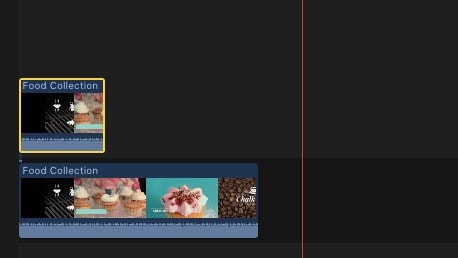
Step 2: Add PIP videos
It is time to choose the higher video clip so that the PIP effect can be applied. This task can be done either by using on-screen type controls available on the viewer or you can move ahead with transform controls available on the inspector.
Note that lower clips use to stay in the background in final results whereas upper clips will appear in the foreground. By default, both clips use to have 100% full screen with 100% opaque settings.
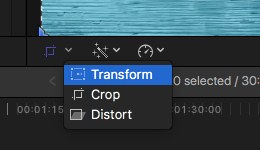
Step 3: Apply PIP effect
As now you have added both videos on-screen now you have to select the higher video and then click over the rectangular transform button that is available on the lower-left corner of viewer screen. As soon as you make this selection, the icon will turn into blue color, and naturally 8 dots will appear around the selected image or video. Use any one of these dots for scaling your selection in asymmetrical order.

Step 4: Adjust PIP Effect
- If you want to scale this image in a symmetrical fashion then simply drag the dot to the corner from the central position.
- Now hold the option key and drag one dot to the corner. It will help you to shrink as well as to enlarge the image even without affecting its actual aspect ratio.
- Users can keep on scaling this foreground image till the time they achieve essential size.
- Now click inside your selected image and start dragging it to reach a certain specific position. You can place it anywhere on a big screen.
Step 5: Follow precise Adjustment
Simply select the top clip and then hit Command + 4 to open the inspector. Now click on that blue show button over your FCP screen and it will provide you complete information about the transform category of available built-in effects. If you use inspector for this task then it can help you to get very precise results for scaling needs. It assists users to manage images with accurate position and size.

Step 6: Apply Cross- Dissolve
- Now choose the leading edge of effect and use Command + T. It will immediately apply the default cross-dissolve option for starting clip.
- You will be glad to know that the PIP effect does not restrict users to work just upon a single image rather it can be used to process as many pictures as your project needs and that can fit inside the frame.
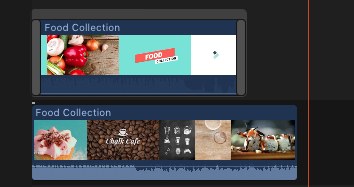
Check this video tutorial to know more details:
Picture in Picture Plug-ins for Final Cut Pro
There are so many plug-ins available in the market for Final Cut Pro platform and all of them possess unique qualities along with impressive toolsets. No matter whether you are a beginner with the PIP effect or professional making high-end video projects, FCP plug-ins can make your task much easier with their intuitive controls.
1. Tokyo PiPintor
PiPintor Free is a specially designed picture-in-picture plugin that assists beginners with easy processing of the PIP effect over Final Cut Pro platform. It simply awakes the menu-driven animation power on your tool so that picture in picture effect can be completed without key-framing.
2. ProPIP
Those who need to enjoy a higher level of customizations are advised to work over ProPIP environment. This advanced tool assists users to showcase their abilities with full freedom for personalization.
ProPIP is the best choice for newscasting, commentaries, and many other applications. It helps in generating fine controls for initial as well as end position, rotation, and scaling effects along with easy-to-use media controls over the screen. ProPIP also provides personalized borders with endless opportunities to develop impressive projects on Final Cut Pro platform.

Benjamin Arango
Benjamin Arango is a writer and a lover of all things video.
Follow @Benjamin Arango
Benjamin Arango
Mar 27, 2024• Proven solutions
Sometimes we need to show two videos together on the same screen to convey certain usage information. If you are searching for a tool to make this task possible then Final Cut Pro is the best choice for you.
This tool can help you to use the picture-in-picture effect with ease. However, the process for adding this effect cannot be completed within one r two steps.
The article below contains complete details about how to add PIP effects using Final Cut Pro. You will be glad to know that FCP also works with few integrated plugins that assist in the free picture in picture effect generation.
How to Create PIP Effect with FCP
If you are ready with two videos and now want to bring them to the same screen then prefer to follow these simple steps:
Step 1: Add Background video
The very first step that you need to follow for PIP effect generation using FCP is to bring your main or background video to the timeline as a primary storyline. Once you have created the primary storyline then all videos for the PIP effect will be added to it.

Step 2: Add PIP videos
It is time to choose the higher video clip so that the PIP effect can be applied. This task can be done either by using on-screen type controls available on the viewer or you can move ahead with transform controls available on the inspector.
Note that lower clips use to stay in the background in final results whereas upper clips will appear in the foreground. By default, both clips use to have 100% full screen with 100% opaque settings.

Step 3: Apply PIP effect
As now you have added both videos on-screen now you have to select the higher video and then click over the rectangular transform button that is available on the lower-left corner of viewer screen. As soon as you make this selection, the icon will turn into blue color, and naturally 8 dots will appear around the selected image or video. Use any one of these dots for scaling your selection in asymmetrical order.

Step 4: Adjust PIP Effect
- If you want to scale this image in a symmetrical fashion then simply drag the dot to the corner from the central position.
- Now hold the option key and drag one dot to the corner. It will help you to shrink as well as to enlarge the image even without affecting its actual aspect ratio.
- Users can keep on scaling this foreground image till the time they achieve essential size.
- Now click inside your selected image and start dragging it to reach a certain specific position. You can place it anywhere on a big screen.
Step 5: Follow precise Adjustment
Simply select the top clip and then hit Command + 4 to open the inspector. Now click on that blue show button over your FCP screen and it will provide you complete information about the transform category of available built-in effects. If you use inspector for this task then it can help you to get very precise results for scaling needs. It assists users to manage images with accurate position and size.

Step 6: Apply Cross- Dissolve
- Now choose the leading edge of effect and use Command + T. It will immediately apply the default cross-dissolve option for starting clip.
- You will be glad to know that the PIP effect does not restrict users to work just upon a single image rather it can be used to process as many pictures as your project needs and that can fit inside the frame.

Check this video tutorial to know more details:
Picture in Picture Plug-ins for Final Cut Pro
There are so many plug-ins available in the market for Final Cut Pro platform and all of them possess unique qualities along with impressive toolsets. No matter whether you are a beginner with the PIP effect or professional making high-end video projects, FCP plug-ins can make your task much easier with their intuitive controls.
1. Tokyo PiPintor
PiPintor Free is a specially designed picture-in-picture plugin that assists beginners with easy processing of the PIP effect over Final Cut Pro platform. It simply awakes the menu-driven animation power on your tool so that picture in picture effect can be completed without key-framing.
2. ProPIP
Those who need to enjoy a higher level of customizations are advised to work over ProPIP environment. This advanced tool assists users to showcase their abilities with full freedom for personalization.
ProPIP is the best choice for newscasting, commentaries, and many other applications. It helps in generating fine controls for initial as well as end position, rotation, and scaling effects along with easy-to-use media controls over the screen. ProPIP also provides personalized borders with endless opportunities to develop impressive projects on Final Cut Pro platform.

Benjamin Arango
Benjamin Arango is a writer and a lover of all things video.
Follow @Benjamin Arango
Benjamin Arango
Mar 27, 2024• Proven solutions
Sometimes we need to show two videos together on the same screen to convey certain usage information. If you are searching for a tool to make this task possible then Final Cut Pro is the best choice for you.
This tool can help you to use the picture-in-picture effect with ease. However, the process for adding this effect cannot be completed within one r two steps.
The article below contains complete details about how to add PIP effects using Final Cut Pro. You will be glad to know that FCP also works with few integrated plugins that assist in the free picture in picture effect generation.
How to Create PIP Effect with FCP
If you are ready with two videos and now want to bring them to the same screen then prefer to follow these simple steps:
Step 1: Add Background video
The very first step that you need to follow for PIP effect generation using FCP is to bring your main or background video to the timeline as a primary storyline. Once you have created the primary storyline then all videos for the PIP effect will be added to it.

Step 2: Add PIP videos
It is time to choose the higher video clip so that the PIP effect can be applied. This task can be done either by using on-screen type controls available on the viewer or you can move ahead with transform controls available on the inspector.
Note that lower clips use to stay in the background in final results whereas upper clips will appear in the foreground. By default, both clips use to have 100% full screen with 100% opaque settings.

Step 3: Apply PIP effect
As now you have added both videos on-screen now you have to select the higher video and then click over the rectangular transform button that is available on the lower-left corner of viewer screen. As soon as you make this selection, the icon will turn into blue color, and naturally 8 dots will appear around the selected image or video. Use any one of these dots for scaling your selection in asymmetrical order.

Step 4: Adjust PIP Effect
- If you want to scale this image in a symmetrical fashion then simply drag the dot to the corner from the central position.
- Now hold the option key and drag one dot to the corner. It will help you to shrink as well as to enlarge the image even without affecting its actual aspect ratio.
- Users can keep on scaling this foreground image till the time they achieve essential size.
- Now click inside your selected image and start dragging it to reach a certain specific position. You can place it anywhere on a big screen.
Step 5: Follow precise Adjustment
Simply select the top clip and then hit Command + 4 to open the inspector. Now click on that blue show button over your FCP screen and it will provide you complete information about the transform category of available built-in effects. If you use inspector for this task then it can help you to get very precise results for scaling needs. It assists users to manage images with accurate position and size.

Step 6: Apply Cross- Dissolve
- Now choose the leading edge of effect and use Command + T. It will immediately apply the default cross-dissolve option for starting clip.
- You will be glad to know that the PIP effect does not restrict users to work just upon a single image rather it can be used to process as many pictures as your project needs and that can fit inside the frame.

Check this video tutorial to know more details:
Picture in Picture Plug-ins for Final Cut Pro
There are so many plug-ins available in the market for Final Cut Pro platform and all of them possess unique qualities along with impressive toolsets. No matter whether you are a beginner with the PIP effect or professional making high-end video projects, FCP plug-ins can make your task much easier with their intuitive controls.
1. Tokyo PiPintor
PiPintor Free is a specially designed picture-in-picture plugin that assists beginners with easy processing of the PIP effect over Final Cut Pro platform. It simply awakes the menu-driven animation power on your tool so that picture in picture effect can be completed without key-framing.
2. ProPIP
Those who need to enjoy a higher level of customizations are advised to work over ProPIP environment. This advanced tool assists users to showcase their abilities with full freedom for personalization.
ProPIP is the best choice for newscasting, commentaries, and many other applications. It helps in generating fine controls for initial as well as end position, rotation, and scaling effects along with easy-to-use media controls over the screen. ProPIP also provides personalized borders with endless opportunities to develop impressive projects on Final Cut Pro platform.

Benjamin Arango
Benjamin Arango is a writer and a lover of all things video.
Follow @Benjamin Arango
Benjamin Arango
Mar 27, 2024• Proven solutions
Sometimes we need to show two videos together on the same screen to convey certain usage information. If you are searching for a tool to make this task possible then Final Cut Pro is the best choice for you.
This tool can help you to use the picture-in-picture effect with ease. However, the process for adding this effect cannot be completed within one r two steps.
The article below contains complete details about how to add PIP effects using Final Cut Pro. You will be glad to know that FCP also works with few integrated plugins that assist in the free picture in picture effect generation.
How to Create PIP Effect with FCP
If you are ready with two videos and now want to bring them to the same screen then prefer to follow these simple steps:
Step 1: Add Background video
The very first step that you need to follow for PIP effect generation using FCP is to bring your main or background video to the timeline as a primary storyline. Once you have created the primary storyline then all videos for the PIP effect will be added to it.

Step 2: Add PIP videos
It is time to choose the higher video clip so that the PIP effect can be applied. This task can be done either by using on-screen type controls available on the viewer or you can move ahead with transform controls available on the inspector.
Note that lower clips use to stay in the background in final results whereas upper clips will appear in the foreground. By default, both clips use to have 100% full screen with 100% opaque settings.

Step 3: Apply PIP effect
As now you have added both videos on-screen now you have to select the higher video and then click over the rectangular transform button that is available on the lower-left corner of viewer screen. As soon as you make this selection, the icon will turn into blue color, and naturally 8 dots will appear around the selected image or video. Use any one of these dots for scaling your selection in asymmetrical order.

Step 4: Adjust PIP Effect
- If you want to scale this image in a symmetrical fashion then simply drag the dot to the corner from the central position.
- Now hold the option key and drag one dot to the corner. It will help you to shrink as well as to enlarge the image even without affecting its actual aspect ratio.
- Users can keep on scaling this foreground image till the time they achieve essential size.
- Now click inside your selected image and start dragging it to reach a certain specific position. You can place it anywhere on a big screen.
Step 5: Follow precise Adjustment
Simply select the top clip and then hit Command + 4 to open the inspector. Now click on that blue show button over your FCP screen and it will provide you complete information about the transform category of available built-in effects. If you use inspector for this task then it can help you to get very precise results for scaling needs. It assists users to manage images with accurate position and size.

Step 6: Apply Cross- Dissolve
- Now choose the leading edge of effect and use Command + T. It will immediately apply the default cross-dissolve option for starting clip.
- You will be glad to know that the PIP effect does not restrict users to work just upon a single image rather it can be used to process as many pictures as your project needs and that can fit inside the frame.

Check this video tutorial to know more details:
Picture in Picture Plug-ins for Final Cut Pro
There are so many plug-ins available in the market for Final Cut Pro platform and all of them possess unique qualities along with impressive toolsets. No matter whether you are a beginner with the PIP effect or professional making high-end video projects, FCP plug-ins can make your task much easier with their intuitive controls.
1. Tokyo PiPintor
PiPintor Free is a specially designed picture-in-picture plugin that assists beginners with easy processing of the PIP effect over Final Cut Pro platform. It simply awakes the menu-driven animation power on your tool so that picture in picture effect can be completed without key-framing.
2. ProPIP
Those who need to enjoy a higher level of customizations are advised to work over ProPIP environment. This advanced tool assists users to showcase their abilities with full freedom for personalization.
ProPIP is the best choice for newscasting, commentaries, and many other applications. It helps in generating fine controls for initial as well as end position, rotation, and scaling effects along with easy-to-use media controls over the screen. ProPIP also provides personalized borders with endless opportunities to develop impressive projects on Final Cut Pro platform.

Benjamin Arango
Benjamin Arango is a writer and a lover of all things video.
Follow @Benjamin Arango
Video Formatting Made Easy: Change Shape, Size, and Aspect Ratio
How to Change Shape of a Video?

Liza Brown
Mar 27, 2024• Proven solutions
While most videos nowadays are rectangular, and are recorded in either landscape or portrait orientation, there are some social media platforms that require the clips to be square shaped. If you want to upload your footages on such websites, it is essential to learn how to change video shape.
Another benefit of changing the shape of the recorded films is that they can be adjusted in limited amount of space, especially if they are to be posted on a website. Furthermore, some fancy designs such as star-shaped or circle-shaped videos attract more attention when used in digital marketing campaigns.
With that said, here you will learn how to change the shape of a video using one of the most advanced and versatile post-production tools, Wondershare Filmora.
Want to learn more about aspect ratio of your video? Click here!
Or, you just want to transfer your video into vertical.
Part 1: How to Change Video Shape from Rectangle to Square
Depending on the recording device and the target audiences a video is intended to be distributed to, the aspect ratio of the produced footage could be 16:9, 4:3, or 21:9 that makes the film rectangular-shaped. Given that, the aspect ratio can be modified to change the film shape from rectangle to square.
The instructions given below explain how to change video shape from rectangle to square in Wondershare Filmora:
Step 1: Import Video to Timeline
Launch Wondershare Filmora on your PC (a Windows 10 computer is used here), click the Add Files icon from the center of the Media window present at the upper-left section, and use the Open box that appears to select and import the source video to Filmora. Next, drag the video from the Media window to the Timeline, and select your preferred option when/if the Project Setting confirmation box appears.
Step 2: Change Aspect Ratio
Select the video in the Timeline, and click the Crop and Zoom icon from the upper-left area of the Timeline itself. On the Crop and Zoom window that opens next, select 1:1 from the Ratio drop-down list, and click OK to save the new setting.
Step 3: Export the Video
Click EXPORT from the top-center area of the interface, go to the Local tab on the Export box, select your preferred format from the Format list in the left pane, optionally click SETTINGS from the right window to make other adjustments if necessary, and click EXPORT from the bottom-right corner of the box.
For more details, please refer to this article: How to Resize a Video to Right Aspect Ratio and Size.
Part 2: Change Video Shape by Cropping
If your preferred aspect ratio isn’t available in the ‘Ratio’ drop-down list of the ‘Crop and Zoom’ window, Wondershare Filmora allows you to manually change the video to a custom shape.

You can learn how to change the shape of a video to an unlisted aspect ratio by following the instructions given below:
Step 1: Import the Video and Get to the Crop and Zoom Window
Follow the method explained in Step 1 of Part 1 to import a video to Wondershare Filmora, and then add it to the Timeline.
Step 2: Select Custom Ratio
Select the video in the Timeline, and click the Crop and Zoom icon as explained earlier to open its window. Next, select Custom from the Ratio drop-down list to be able to crop the videos unproportionally.
Step 3: Crop the Video Manually
Drag the cropping handles from any one edge of the video. Repeat this process for all the four sides to select the area of interest. Click OK to save the changes.
Step 4: Export the Video
Follow the process explained in Step 3 of Part 1 to export the modified video.
Part 3: Change Video Shape to Circle or Other Shapes in Filmora
Another, rather better way of changing videos to custom shapes is with the help of image or shape masking.
In Filmora you can apply image masks either from the existing presets, i.e. circle, star, diamond, etc., or you can add custom photos if need be. Professionals generally use custom pictures to create fancy logos and titles.
On the other hand, shape masking allows you to mask a background video with a foreground footage in a custom shape.
Although the basic concept of both types of masking is same, the options available under each can be used to produce effective outputs.
That said, following are the instructions to apply both types of masking to your videos:
Image Masking
The steps given below explain how to change video shape with image masking in Filmora:
Step 1: Add Clip to Timeline
Use the method explained in the previous sections to import a clip and add it to the Timeline.
Step 2: Add Image Mask
Click Effects from the standard toolbar at the top, select Utility from the left pane, drag Image Mask from the Utility window, and drop it on top of the video itself in the Timeline. Notice how the fx icon appears on the video layer showing that the effect has been successfully added.
Step 3: Customize Image Mask
On the Timeline, double-click the video layer you applied Image Mask to, and notice all the available shapes available under the Preset Mask section on the Video Effects > Image Mask window that appears at the upper-left area. You can double-click any of the available shape presets to apply it to the video layer. In addition, drag the X and Y, and Width, Height, and Feather sliders to adjust the mask’s position, size, and edge smoothness respectively. You can also check the Invert Mask box to reverse the masking effect on the video. Finally, click OK to save the changes, and follow the method explained in earlier parts to export the video.
Shape Masking
The following steps explain how to change the shape of a video with shape masks in Filmora:
Step 1: Get to the Utility Window
Add at two footages on their individual layers in the Timeline (make sure to place the second layer above the first one), and follow the method explained above to get to the Effects > Utility window.
Step 2: Add Shape Mask
Drag Shape Mask from the Utility window, and drop it on top of the video itself in the Timeline. Confirm that the fx icon appears on the video layer to ensure that the effect has been applied.
Step 3: Customize Shape Mask
Double-click the video layer in the Timeline you applied shape mask to. On the Video Effects > Shape Mask window, use the X and Y, and Width, Height, and Feather sliders to adjust the mask’s position, size and edge smoothness respectively. Optionally check the Invert Mask box to reverse the masking effect, and click OK to save the settings. Next, follow the method explained earlier to export the video.
FAQs
1. What’s the difference between Image Mask and Shape Mask in Filmora?
A) In Filmora, Image Mask allows you to use an image (or any available preset) for masking so that the background footage is cropped to the shape of the picture. This is generally used to create logos and dynamic titles for movies or documentaries. On the other hand, Shape Mask enables you to mask the background clip with the foreground footage in the form of a shape that could be positioned and customized using the available sliders.
2. How many image masks are available in Filmora?
A) At the time of this writing, Wondershare Filmora has around 40 image mask presets. In addition, it also allows you to add custom images from your PC for more dynamic approach.

Liza Brown
Liza Brown is a writer and a lover of all things video.
Follow @Liza Brown
Liza Brown
Mar 27, 2024• Proven solutions
While most videos nowadays are rectangular, and are recorded in either landscape or portrait orientation, there are some social media platforms that require the clips to be square shaped. If you want to upload your footages on such websites, it is essential to learn how to change video shape.
Another benefit of changing the shape of the recorded films is that they can be adjusted in limited amount of space, especially if they are to be posted on a website. Furthermore, some fancy designs such as star-shaped or circle-shaped videos attract more attention when used in digital marketing campaigns.
With that said, here you will learn how to change the shape of a video using one of the most advanced and versatile post-production tools, Wondershare Filmora.
Want to learn more about aspect ratio of your video? Click here!
Or, you just want to transfer your video into vertical.
Part 1: How to Change Video Shape from Rectangle to Square
Depending on the recording device and the target audiences a video is intended to be distributed to, the aspect ratio of the produced footage could be 16:9, 4:3, or 21:9 that makes the film rectangular-shaped. Given that, the aspect ratio can be modified to change the film shape from rectangle to square.
The instructions given below explain how to change video shape from rectangle to square in Wondershare Filmora:
Step 1: Import Video to Timeline
Launch Wondershare Filmora on your PC (a Windows 10 computer is used here), click the Add Files icon from the center of the Media window present at the upper-left section, and use the Open box that appears to select and import the source video to Filmora. Next, drag the video from the Media window to the Timeline, and select your preferred option when/if the Project Setting confirmation box appears.
Step 2: Change Aspect Ratio
Select the video in the Timeline, and click the Crop and Zoom icon from the upper-left area of the Timeline itself. On the Crop and Zoom window that opens next, select 1:1 from the Ratio drop-down list, and click OK to save the new setting.
Step 3: Export the Video
Click EXPORT from the top-center area of the interface, go to the Local tab on the Export box, select your preferred format from the Format list in the left pane, optionally click SETTINGS from the right window to make other adjustments if necessary, and click EXPORT from the bottom-right corner of the box.
For more details, please refer to this article: How to Resize a Video to Right Aspect Ratio and Size.
Part 2: Change Video Shape by Cropping
If your preferred aspect ratio isn’t available in the ‘Ratio’ drop-down list of the ‘Crop and Zoom’ window, Wondershare Filmora allows you to manually change the video to a custom shape.

You can learn how to change the shape of a video to an unlisted aspect ratio by following the instructions given below:
Step 1: Import the Video and Get to the Crop and Zoom Window
Follow the method explained in Step 1 of Part 1 to import a video to Wondershare Filmora, and then add it to the Timeline.
Step 2: Select Custom Ratio
Select the video in the Timeline, and click the Crop and Zoom icon as explained earlier to open its window. Next, select Custom from the Ratio drop-down list to be able to crop the videos unproportionally.
Step 3: Crop the Video Manually
Drag the cropping handles from any one edge of the video. Repeat this process for all the four sides to select the area of interest. Click OK to save the changes.
Step 4: Export the Video
Follow the process explained in Step 3 of Part 1 to export the modified video.
Part 3: Change Video Shape to Circle or Other Shapes in Filmora
Another, rather better way of changing videos to custom shapes is with the help of image or shape masking.
In Filmora you can apply image masks either from the existing presets, i.e. circle, star, diamond, etc., or you can add custom photos if need be. Professionals generally use custom pictures to create fancy logos and titles.
On the other hand, shape masking allows you to mask a background video with a foreground footage in a custom shape.
Although the basic concept of both types of masking is same, the options available under each can be used to produce effective outputs.
That said, following are the instructions to apply both types of masking to your videos:
Image Masking
The steps given below explain how to change video shape with image masking in Filmora:
Step 1: Add Clip to Timeline
Use the method explained in the previous sections to import a clip and add it to the Timeline.
Step 2: Add Image Mask
Click Effects from the standard toolbar at the top, select Utility from the left pane, drag Image Mask from the Utility window, and drop it on top of the video itself in the Timeline. Notice how the fx icon appears on the video layer showing that the effect has been successfully added.
Step 3: Customize Image Mask
On the Timeline, double-click the video layer you applied Image Mask to, and notice all the available shapes available under the Preset Mask section on the Video Effects > Image Mask window that appears at the upper-left area. You can double-click any of the available shape presets to apply it to the video layer. In addition, drag the X and Y, and Width, Height, and Feather sliders to adjust the mask’s position, size, and edge smoothness respectively. You can also check the Invert Mask box to reverse the masking effect on the video. Finally, click OK to save the changes, and follow the method explained in earlier parts to export the video.
Shape Masking
The following steps explain how to change the shape of a video with shape masks in Filmora:
Step 1: Get to the Utility Window
Add at two footages on their individual layers in the Timeline (make sure to place the second layer above the first one), and follow the method explained above to get to the Effects > Utility window.
Step 2: Add Shape Mask
Drag Shape Mask from the Utility window, and drop it on top of the video itself in the Timeline. Confirm that the fx icon appears on the video layer to ensure that the effect has been applied.
Step 3: Customize Shape Mask
Double-click the video layer in the Timeline you applied shape mask to. On the Video Effects > Shape Mask window, use the X and Y, and Width, Height, and Feather sliders to adjust the mask’s position, size and edge smoothness respectively. Optionally check the Invert Mask box to reverse the masking effect, and click OK to save the settings. Next, follow the method explained earlier to export the video.
FAQs
1. What’s the difference between Image Mask and Shape Mask in Filmora?
A) In Filmora, Image Mask allows you to use an image (or any available preset) for masking so that the background footage is cropped to the shape of the picture. This is generally used to create logos and dynamic titles for movies or documentaries. On the other hand, Shape Mask enables you to mask the background clip with the foreground footage in the form of a shape that could be positioned and customized using the available sliders.
2. How many image masks are available in Filmora?
A) At the time of this writing, Wondershare Filmora has around 40 image mask presets. In addition, it also allows you to add custom images from your PC for more dynamic approach.

Liza Brown
Liza Brown is a writer and a lover of all things video.
Follow @Liza Brown
Liza Brown
Mar 27, 2024• Proven solutions
While most videos nowadays are rectangular, and are recorded in either landscape or portrait orientation, there are some social media platforms that require the clips to be square shaped. If you want to upload your footages on such websites, it is essential to learn how to change video shape.
Another benefit of changing the shape of the recorded films is that they can be adjusted in limited amount of space, especially if they are to be posted on a website. Furthermore, some fancy designs such as star-shaped or circle-shaped videos attract more attention when used in digital marketing campaigns.
With that said, here you will learn how to change the shape of a video using one of the most advanced and versatile post-production tools, Wondershare Filmora.
Want to learn more about aspect ratio of your video? Click here!
Or, you just want to transfer your video into vertical.
Part 1: How to Change Video Shape from Rectangle to Square
Depending on the recording device and the target audiences a video is intended to be distributed to, the aspect ratio of the produced footage could be 16:9, 4:3, or 21:9 that makes the film rectangular-shaped. Given that, the aspect ratio can be modified to change the film shape from rectangle to square.
The instructions given below explain how to change video shape from rectangle to square in Wondershare Filmora:
Step 1: Import Video to Timeline
Launch Wondershare Filmora on your PC (a Windows 10 computer is used here), click the Add Files icon from the center of the Media window present at the upper-left section, and use the Open box that appears to select and import the source video to Filmora. Next, drag the video from the Media window to the Timeline, and select your preferred option when/if the Project Setting confirmation box appears.
Step 2: Change Aspect Ratio
Select the video in the Timeline, and click the Crop and Zoom icon from the upper-left area of the Timeline itself. On the Crop and Zoom window that opens next, select 1:1 from the Ratio drop-down list, and click OK to save the new setting.
Step 3: Export the Video
Click EXPORT from the top-center area of the interface, go to the Local tab on the Export box, select your preferred format from the Format list in the left pane, optionally click SETTINGS from the right window to make other adjustments if necessary, and click EXPORT from the bottom-right corner of the box.
For more details, please refer to this article: How to Resize a Video to Right Aspect Ratio and Size.
Part 2: Change Video Shape by Cropping
If your preferred aspect ratio isn’t available in the ‘Ratio’ drop-down list of the ‘Crop and Zoom’ window, Wondershare Filmora allows you to manually change the video to a custom shape.

You can learn how to change the shape of a video to an unlisted aspect ratio by following the instructions given below:
Step 1: Import the Video and Get to the Crop and Zoom Window
Follow the method explained in Step 1 of Part 1 to import a video to Wondershare Filmora, and then add it to the Timeline.
Step 2: Select Custom Ratio
Select the video in the Timeline, and click the Crop and Zoom icon as explained earlier to open its window. Next, select Custom from the Ratio drop-down list to be able to crop the videos unproportionally.
Step 3: Crop the Video Manually
Drag the cropping handles from any one edge of the video. Repeat this process for all the four sides to select the area of interest. Click OK to save the changes.
Step 4: Export the Video
Follow the process explained in Step 3 of Part 1 to export the modified video.
Part 3: Change Video Shape to Circle or Other Shapes in Filmora
Another, rather better way of changing videos to custom shapes is with the help of image or shape masking.
In Filmora you can apply image masks either from the existing presets, i.e. circle, star, diamond, etc., or you can add custom photos if need be. Professionals generally use custom pictures to create fancy logos and titles.
On the other hand, shape masking allows you to mask a background video with a foreground footage in a custom shape.
Although the basic concept of both types of masking is same, the options available under each can be used to produce effective outputs.
That said, following are the instructions to apply both types of masking to your videos:
Image Masking
The steps given below explain how to change video shape with image masking in Filmora:
Step 1: Add Clip to Timeline
Use the method explained in the previous sections to import a clip and add it to the Timeline.
Step 2: Add Image Mask
Click Effects from the standard toolbar at the top, select Utility from the left pane, drag Image Mask from the Utility window, and drop it on top of the video itself in the Timeline. Notice how the fx icon appears on the video layer showing that the effect has been successfully added.
Step 3: Customize Image Mask
On the Timeline, double-click the video layer you applied Image Mask to, and notice all the available shapes available under the Preset Mask section on the Video Effects > Image Mask window that appears at the upper-left area. You can double-click any of the available shape presets to apply it to the video layer. In addition, drag the X and Y, and Width, Height, and Feather sliders to adjust the mask’s position, size, and edge smoothness respectively. You can also check the Invert Mask box to reverse the masking effect on the video. Finally, click OK to save the changes, and follow the method explained in earlier parts to export the video.
Shape Masking
The following steps explain how to change the shape of a video with shape masks in Filmora:
Step 1: Get to the Utility Window
Add at two footages on their individual layers in the Timeline (make sure to place the second layer above the first one), and follow the method explained above to get to the Effects > Utility window.
Step 2: Add Shape Mask
Drag Shape Mask from the Utility window, and drop it on top of the video itself in the Timeline. Confirm that the fx icon appears on the video layer to ensure that the effect has been applied.
Step 3: Customize Shape Mask
Double-click the video layer in the Timeline you applied shape mask to. On the Video Effects > Shape Mask window, use the X and Y, and Width, Height, and Feather sliders to adjust the mask’s position, size and edge smoothness respectively. Optionally check the Invert Mask box to reverse the masking effect, and click OK to save the settings. Next, follow the method explained earlier to export the video.
FAQs
1. What’s the difference between Image Mask and Shape Mask in Filmora?
A) In Filmora, Image Mask allows you to use an image (or any available preset) for masking so that the background footage is cropped to the shape of the picture. This is generally used to create logos and dynamic titles for movies or documentaries. On the other hand, Shape Mask enables you to mask the background clip with the foreground footage in the form of a shape that could be positioned and customized using the available sliders.
2. How many image masks are available in Filmora?
A) At the time of this writing, Wondershare Filmora has around 40 image mask presets. In addition, it also allows you to add custom images from your PC for more dynamic approach.

Liza Brown
Liza Brown is a writer and a lover of all things video.
Follow @Liza Brown
Liza Brown
Mar 27, 2024• Proven solutions
While most videos nowadays are rectangular, and are recorded in either landscape or portrait orientation, there are some social media platforms that require the clips to be square shaped. If you want to upload your footages on such websites, it is essential to learn how to change video shape.
Another benefit of changing the shape of the recorded films is that they can be adjusted in limited amount of space, especially if they are to be posted on a website. Furthermore, some fancy designs such as star-shaped or circle-shaped videos attract more attention when used in digital marketing campaigns.
With that said, here you will learn how to change the shape of a video using one of the most advanced and versatile post-production tools, Wondershare Filmora.
Want to learn more about aspect ratio of your video? Click here!
Or, you just want to transfer your video into vertical.
Part 1: How to Change Video Shape from Rectangle to Square
Depending on the recording device and the target audiences a video is intended to be distributed to, the aspect ratio of the produced footage could be 16:9, 4:3, or 21:9 that makes the film rectangular-shaped. Given that, the aspect ratio can be modified to change the film shape from rectangle to square.
The instructions given below explain how to change video shape from rectangle to square in Wondershare Filmora:
Step 1: Import Video to Timeline
Launch Wondershare Filmora on your PC (a Windows 10 computer is used here), click the Add Files icon from the center of the Media window present at the upper-left section, and use the Open box that appears to select and import the source video to Filmora. Next, drag the video from the Media window to the Timeline, and select your preferred option when/if the Project Setting confirmation box appears.
Step 2: Change Aspect Ratio
Select the video in the Timeline, and click the Crop and Zoom icon from the upper-left area of the Timeline itself. On the Crop and Zoom window that opens next, select 1:1 from the Ratio drop-down list, and click OK to save the new setting.
Step 3: Export the Video
Click EXPORT from the top-center area of the interface, go to the Local tab on the Export box, select your preferred format from the Format list in the left pane, optionally click SETTINGS from the right window to make other adjustments if necessary, and click EXPORT from the bottom-right corner of the box.
For more details, please refer to this article: How to Resize a Video to Right Aspect Ratio and Size.
Part 2: Change Video Shape by Cropping
If your preferred aspect ratio isn’t available in the ‘Ratio’ drop-down list of the ‘Crop and Zoom’ window, Wondershare Filmora allows you to manually change the video to a custom shape.

You can learn how to change the shape of a video to an unlisted aspect ratio by following the instructions given below:
Step 1: Import the Video and Get to the Crop and Zoom Window
Follow the method explained in Step 1 of Part 1 to import a video to Wondershare Filmora, and then add it to the Timeline.
Step 2: Select Custom Ratio
Select the video in the Timeline, and click the Crop and Zoom icon as explained earlier to open its window. Next, select Custom from the Ratio drop-down list to be able to crop the videos unproportionally.
Step 3: Crop the Video Manually
Drag the cropping handles from any one edge of the video. Repeat this process for all the four sides to select the area of interest. Click OK to save the changes.
Step 4: Export the Video
Follow the process explained in Step 3 of Part 1 to export the modified video.
Part 3: Change Video Shape to Circle or Other Shapes in Filmora
Another, rather better way of changing videos to custom shapes is with the help of image or shape masking.
In Filmora you can apply image masks either from the existing presets, i.e. circle, star, diamond, etc., or you can add custom photos if need be. Professionals generally use custom pictures to create fancy logos and titles.
On the other hand, shape masking allows you to mask a background video with a foreground footage in a custom shape.
Although the basic concept of both types of masking is same, the options available under each can be used to produce effective outputs.
That said, following are the instructions to apply both types of masking to your videos:
Image Masking
The steps given below explain how to change video shape with image masking in Filmora:
Step 1: Add Clip to Timeline
Use the method explained in the previous sections to import a clip and add it to the Timeline.
Step 2: Add Image Mask
Click Effects from the standard toolbar at the top, select Utility from the left pane, drag Image Mask from the Utility window, and drop it on top of the video itself in the Timeline. Notice how the fx icon appears on the video layer showing that the effect has been successfully added.
Step 3: Customize Image Mask
On the Timeline, double-click the video layer you applied Image Mask to, and notice all the available shapes available under the Preset Mask section on the Video Effects > Image Mask window that appears at the upper-left area. You can double-click any of the available shape presets to apply it to the video layer. In addition, drag the X and Y, and Width, Height, and Feather sliders to adjust the mask’s position, size, and edge smoothness respectively. You can also check the Invert Mask box to reverse the masking effect on the video. Finally, click OK to save the changes, and follow the method explained in earlier parts to export the video.
Shape Masking
The following steps explain how to change the shape of a video with shape masks in Filmora:
Step 1: Get to the Utility Window
Add at two footages on their individual layers in the Timeline (make sure to place the second layer above the first one), and follow the method explained above to get to the Effects > Utility window.
Step 2: Add Shape Mask
Drag Shape Mask from the Utility window, and drop it on top of the video itself in the Timeline. Confirm that the fx icon appears on the video layer to ensure that the effect has been applied.
Step 3: Customize Shape Mask
Double-click the video layer in the Timeline you applied shape mask to. On the Video Effects > Shape Mask window, use the X and Y, and Width, Height, and Feather sliders to adjust the mask’s position, size and edge smoothness respectively. Optionally check the Invert Mask box to reverse the masking effect, and click OK to save the settings. Next, follow the method explained earlier to export the video.
FAQs
1. What’s the difference between Image Mask and Shape Mask in Filmora?
A) In Filmora, Image Mask allows you to use an image (or any available preset) for masking so that the background footage is cropped to the shape of the picture. This is generally used to create logos and dynamic titles for movies or documentaries. On the other hand, Shape Mask enables you to mask the background clip with the foreground footage in the form of a shape that could be positioned and customized using the available sliders.
2. How many image masks are available in Filmora?
A) At the time of this writing, Wondershare Filmora has around 40 image mask presets. In addition, it also allows you to add custom images from your PC for more dynamic approach.

Liza Brown
Liza Brown is a writer and a lover of all things video.
Follow @Liza Brown
Also read:
- Updated No-Cost Video Watermarking Solutions Expert Recommendations for 2024
- Updated In 2024, Green Screen on a Budget Top 10 Free Apps for Android & iOS 2023 Edition
- New 2024 Approved Top-Rated Dailymotion Video Converter for Free
- Updated Ultimate Guide to Highlight Video Editing Software
- New In 2024, S Best Video Combining Software Easy to Use and Highly Effective
- New Windows 10 Video Production Best Software Options for 2024
- Updated In 2024, The Article Below Will Show You some of the Best Apps to Convert a Video to a Live Photo, and How to Set up Live Photos as Wallpaper on iPhone
- New The Ultimate Guide to Adobe Premiere Rush Alternatives (Updated 2023)
- New 2024 Approved Make a Lasting Impression How to Choose the Right Facebook Video Cover Size
- Updated AI-Driven Video Editing Software for Perfect Aspect Ratios for 2024
- New 2024 Approved Top-Rated Free Game Download Sites for PC, Android, and Mobile Devices
- Updated In 2024, Android Essentials Must-Have Apps for Your Device
- New MP3 Magic Converting Soundcloud Tracks with Ease
- Updated Online Video Editors Handbook From Download to Final Cut for 2024
- New In 2024, Loop, Repeat, and Relax Top 10 Free Video Looping Services
- 2024 Approved Unleash Your Inner Toon 16 Fantastic Cartoonizer Apps
- New 7 Best Filmmaking Software You Should Know (Low Budget) for 2024
- In 2024, Videoleap on MacBook A Quick Start Guide to Downloading and Using
- Updated In 2024, Best Free DVD Playback Options for Windows 10 Users
- New Top 16 Free Video Editing Software for Beginners Very Easy to Use
- 2024 Approved Top 16 Best Free Easy Movie Makers
- Updated Top MP4 to MP3 Converter Apps for Mobile Devices
- Updated The Pros and Cons of Final Cut Pro vs Final Cut Express for 2024
- Updated Top 10+ Best Free Online Video Editors for 2024
- Updated In 2024, Elevate Your Videos The Top-Rated iPad Video Editing Apps
- New 2024 Approved Top-Rated Free Video Hosting Services for Individuals, Businesses, and Entrepreneurs
- In 2024, Voice Over Made Easy Final Cut Pro Tips and Tricks for Beginners
- Updated 2024 Approved Screen Sense How Aspect Ratio Selection Impacts Viewer Experience
- Updated Cinematic Storytelling Made Easy A Beginners Handbook
- In 2024, FRP Hijacker by Hagard Download and Bypass your Oppo A18 FRP Locks
- How to Fix Life360 Shows Wrong Location On Nokia C12 Plus? | Dr.fone
- New Best Ways to Blur Zoom Background for Free
- How to use Snapchat Location Spoofer to Protect Your Privacy On Infinix Hot 40i? | Dr.fone
- In 2024, 8 Best Apps for Screen Mirroring Vivo Y100 PC | Dr.fone
- 2 Ways to Transfer Text Messages from Honor Magic V2 to iPhone 15/14/13/12/11/X/8/ | Dr.fone
- In 2024, Does Google Pixel 8 Have Find My Friends? | Dr.fone
- Which is the Best Fake GPS Joystick App On Samsung Galaxy M54 5G? | Dr.fone
- 15 Best Strongest Pokémon To Use in Pokémon GO PvP Leagues For Infinix Smart 8 Pro | Dr.fone
- Guide on How To Erase iPhone X Devices Entirely | Dr.fone
- Full Guide How To Fix Connection Is Not Private on Itel A05s | Dr.fone
- Title: 2024 Approved Watermark-Free Video Editing The Top 7 Merging Solutions
- Author: MdadeLe
- Created at : 2024-05-19 08:27:30
- Updated at : 2024-05-20 08:27:30
- Link: https://smart-video-editing.techidaily.com/2024-approved-watermark-free-video-editing-the-top-7-merging-solutions/
- License: This work is licensed under CC BY-NC-SA 4.0.

